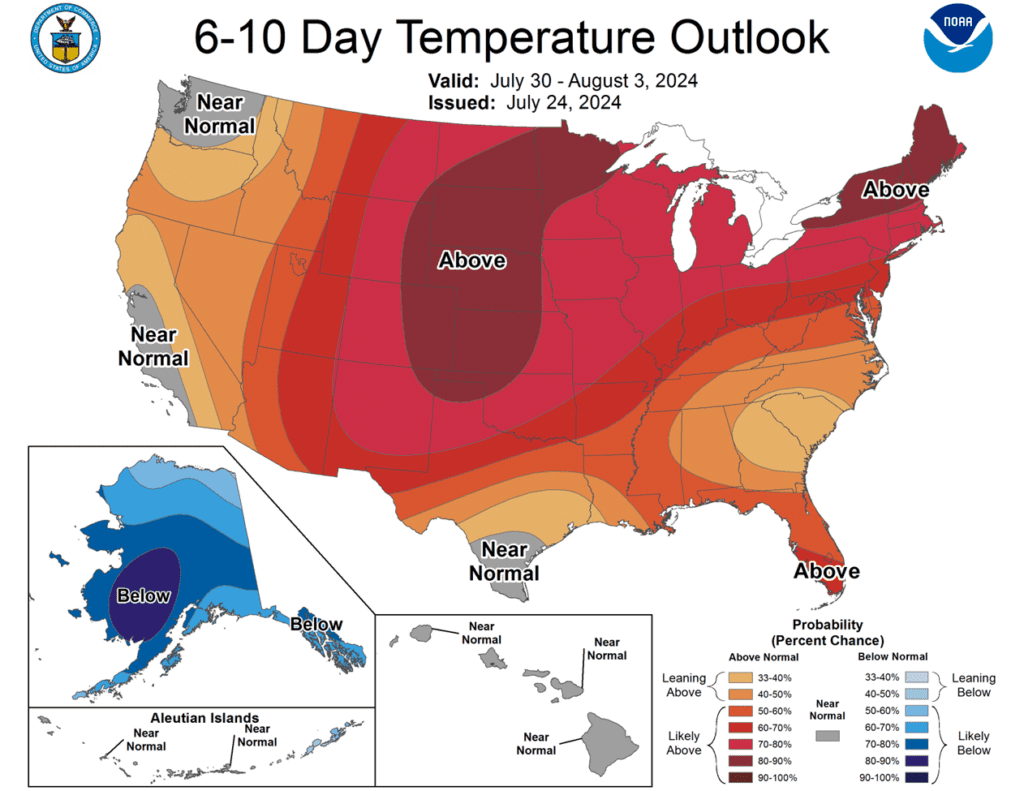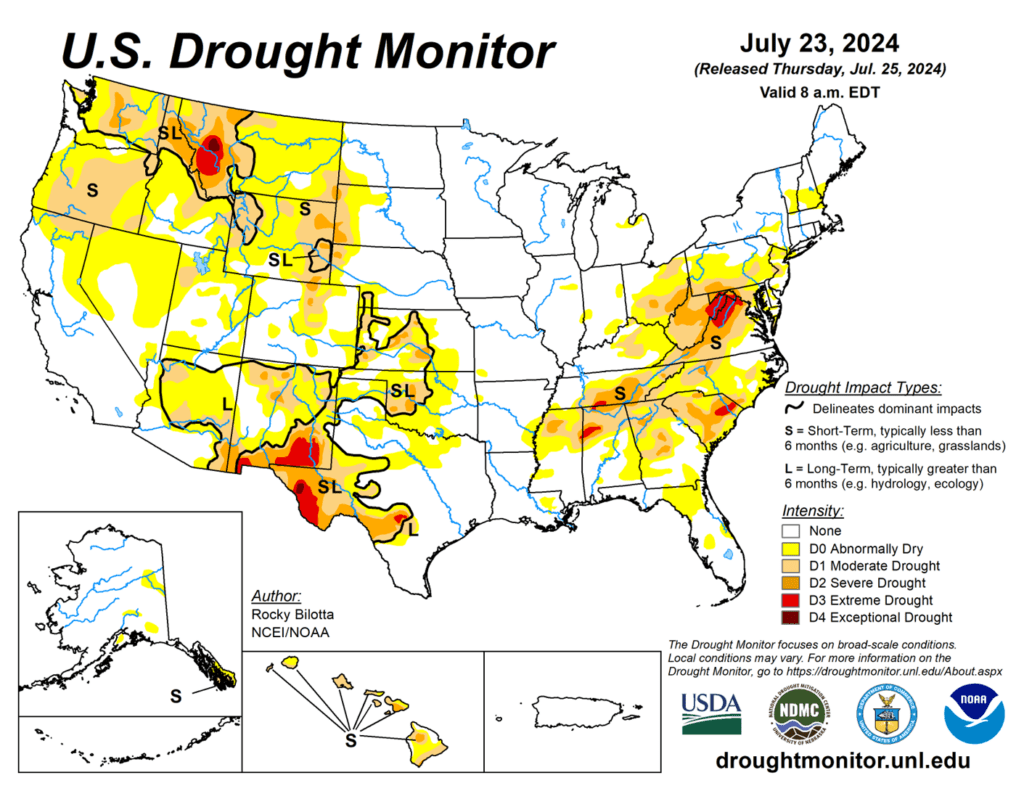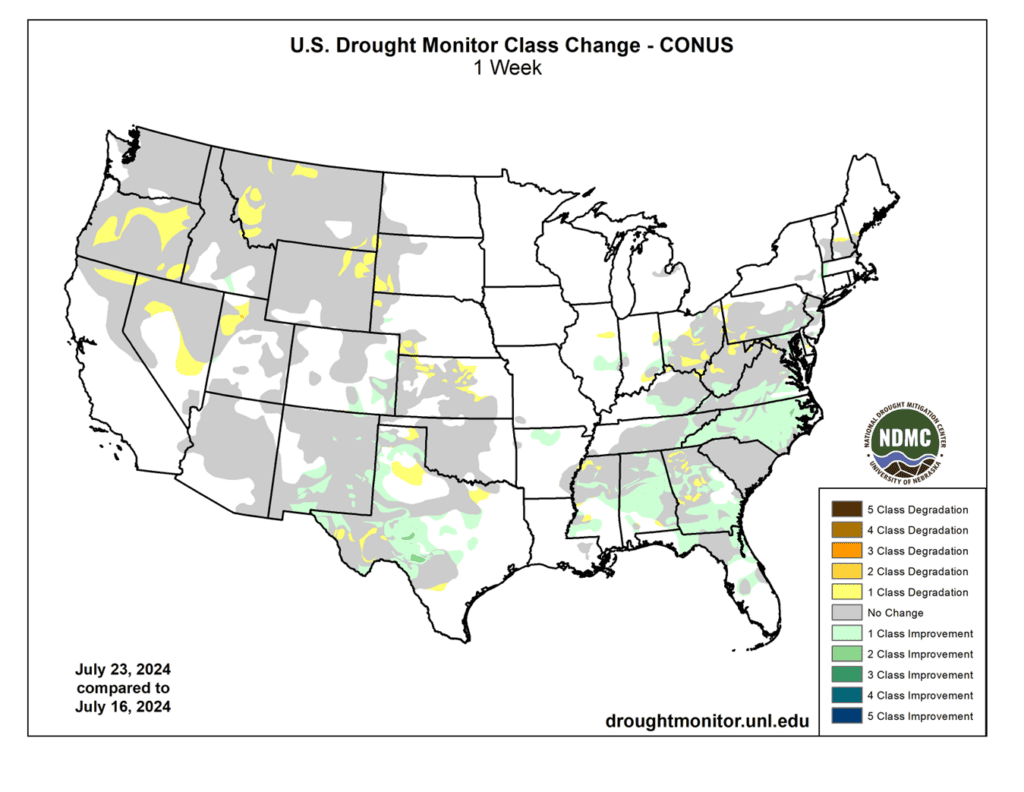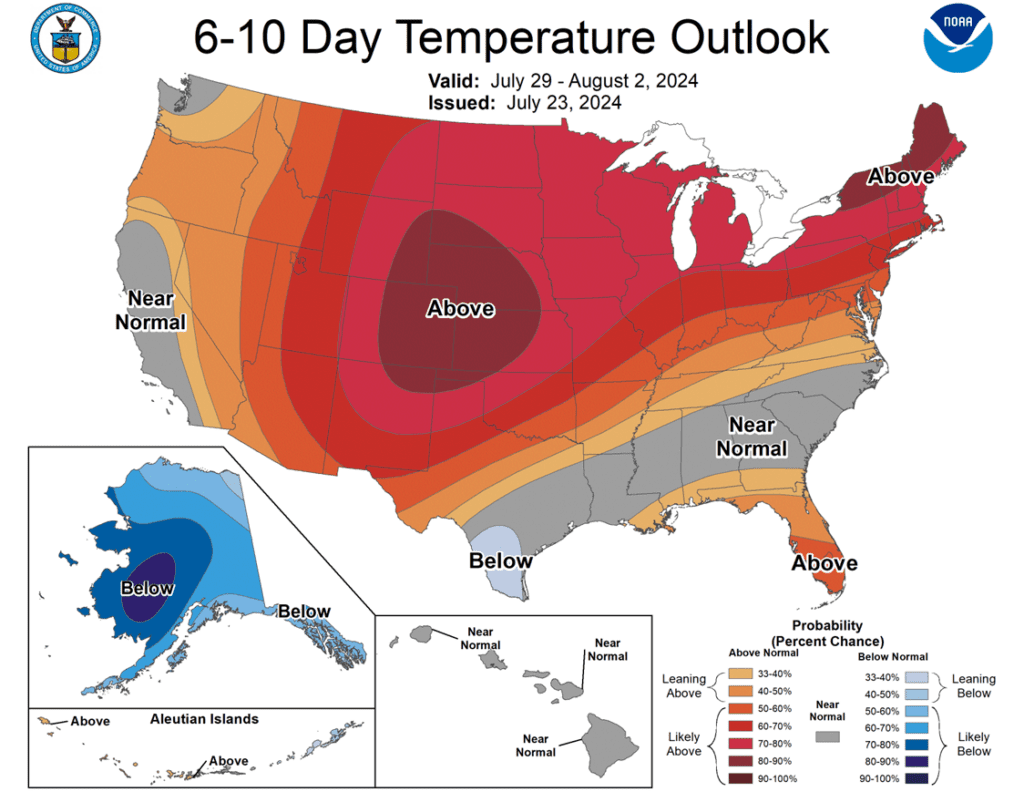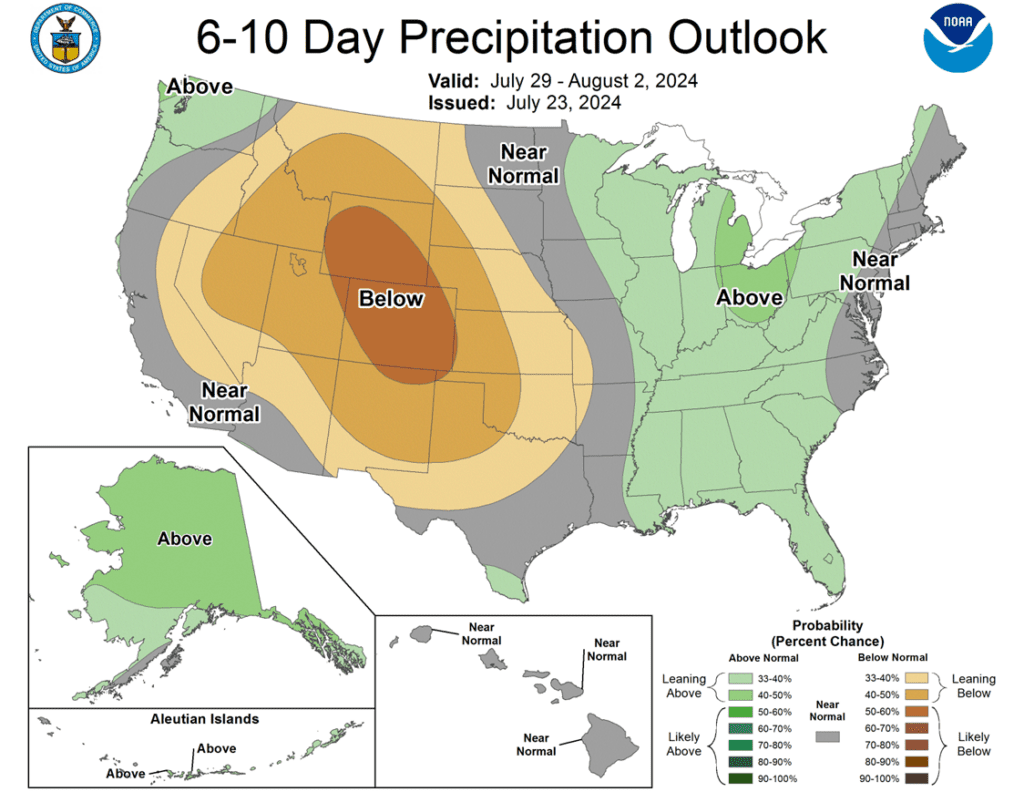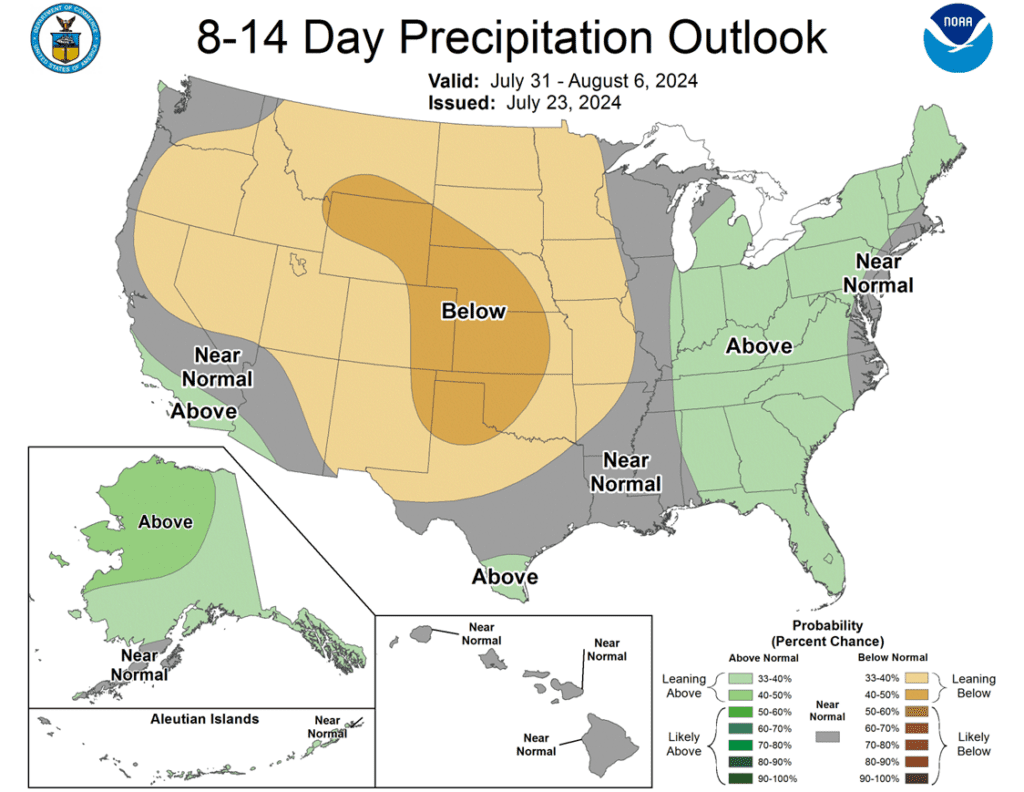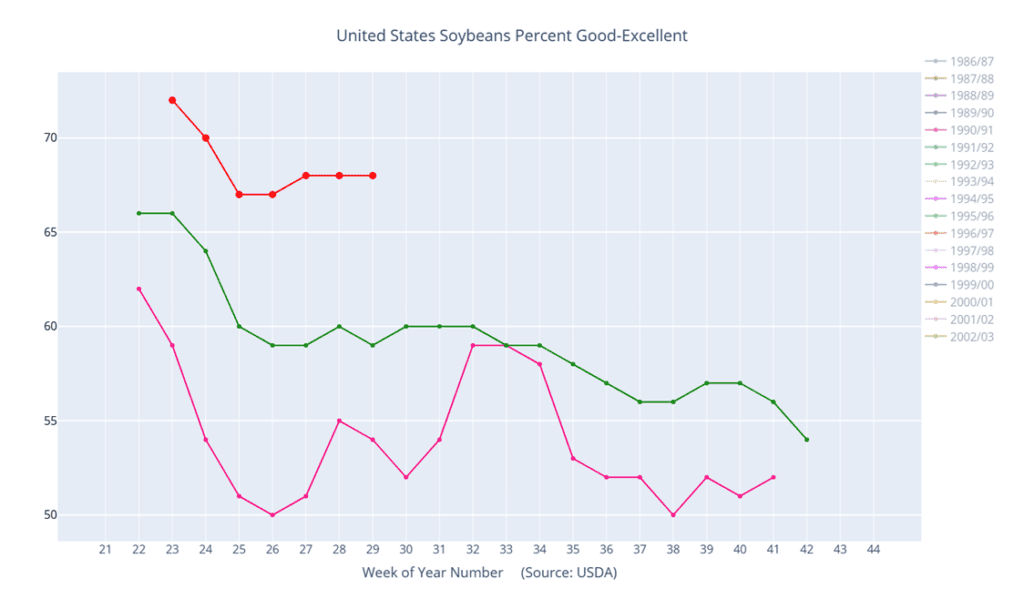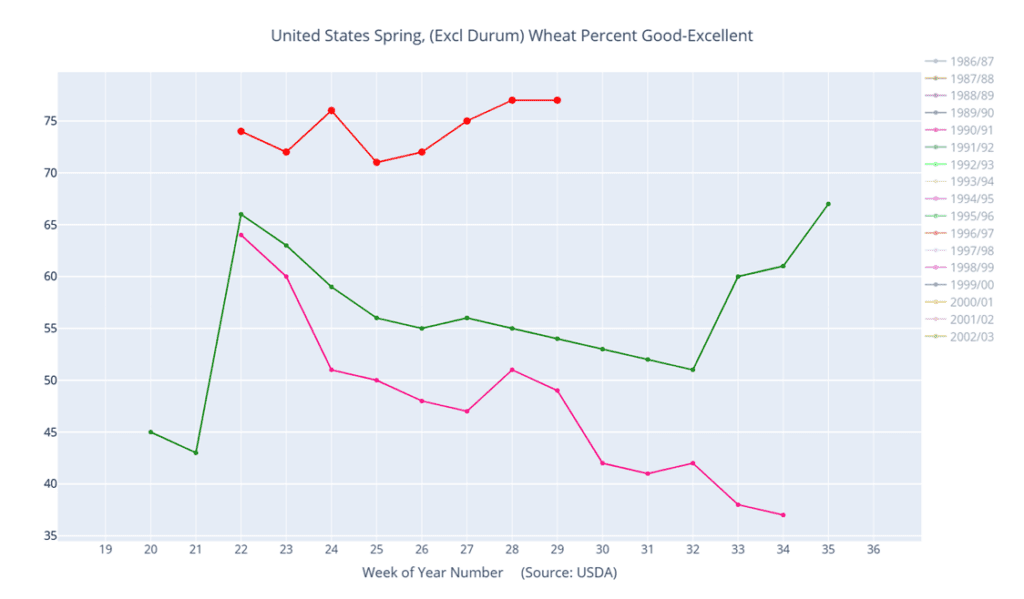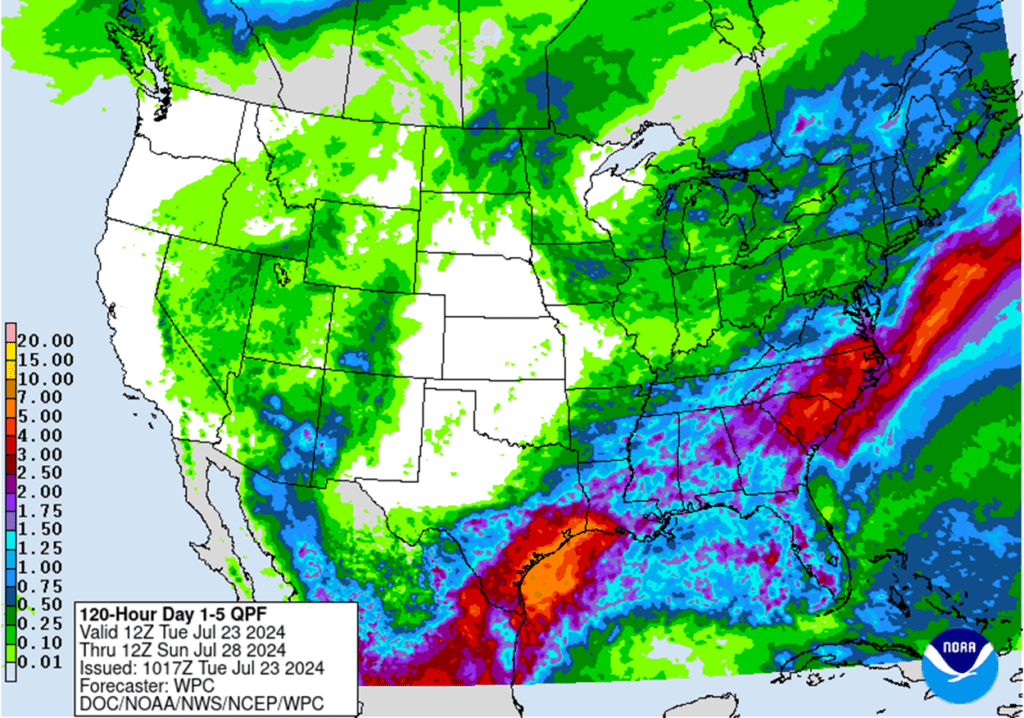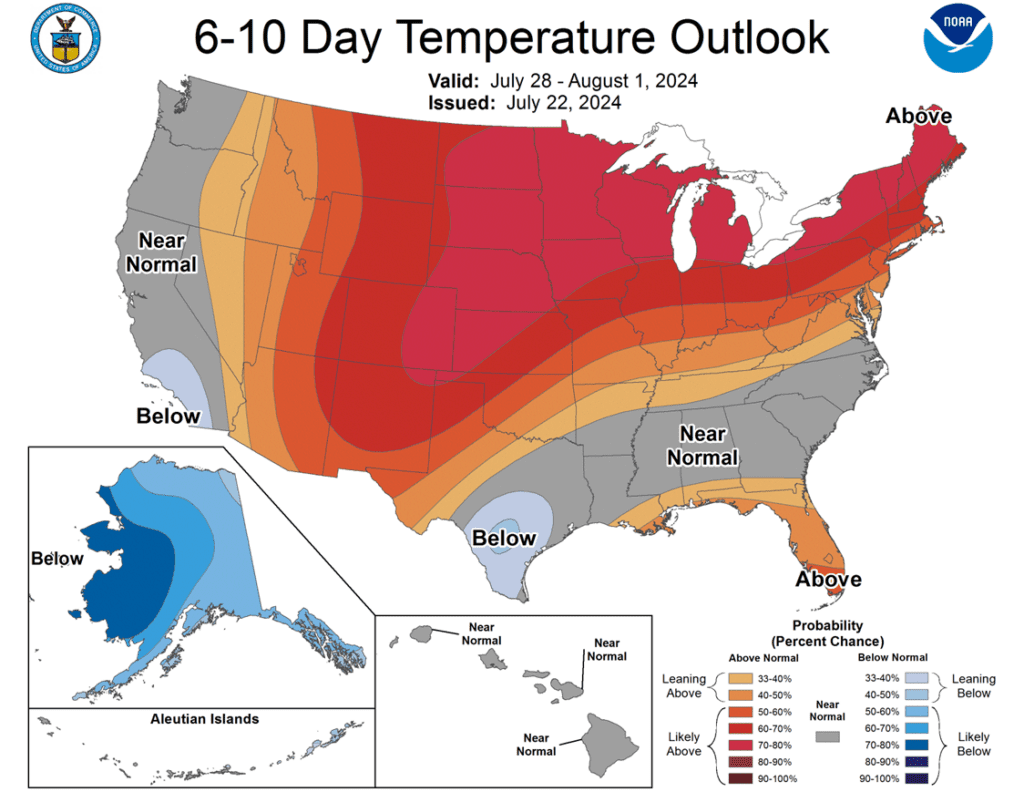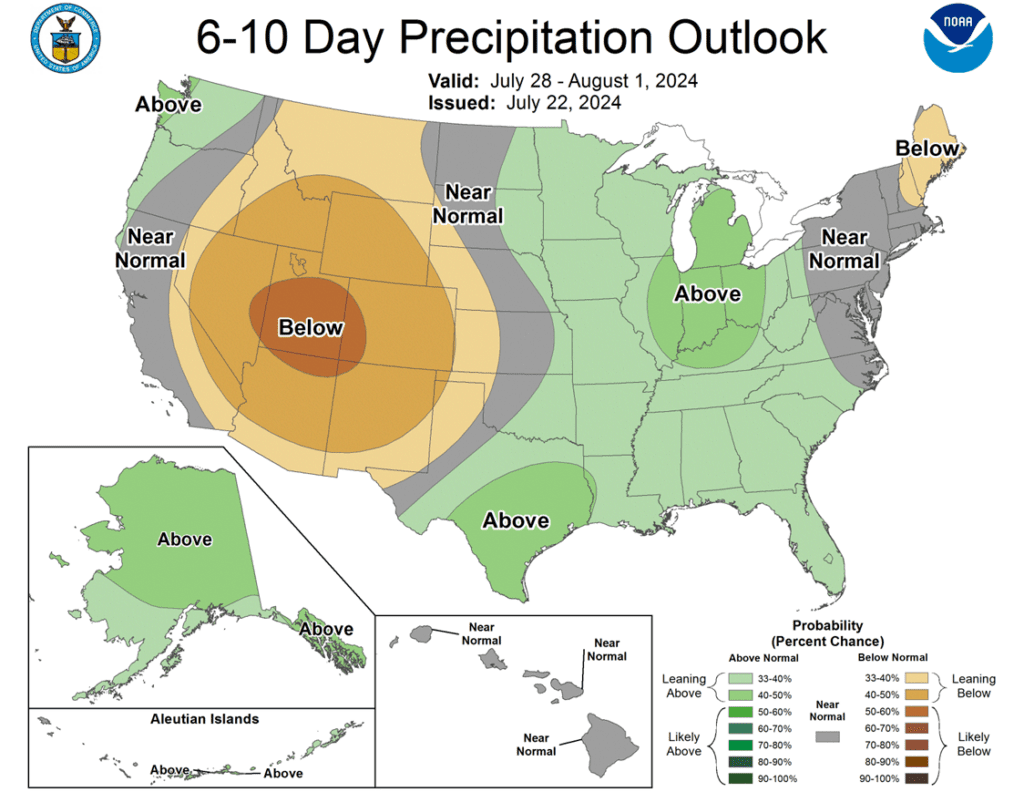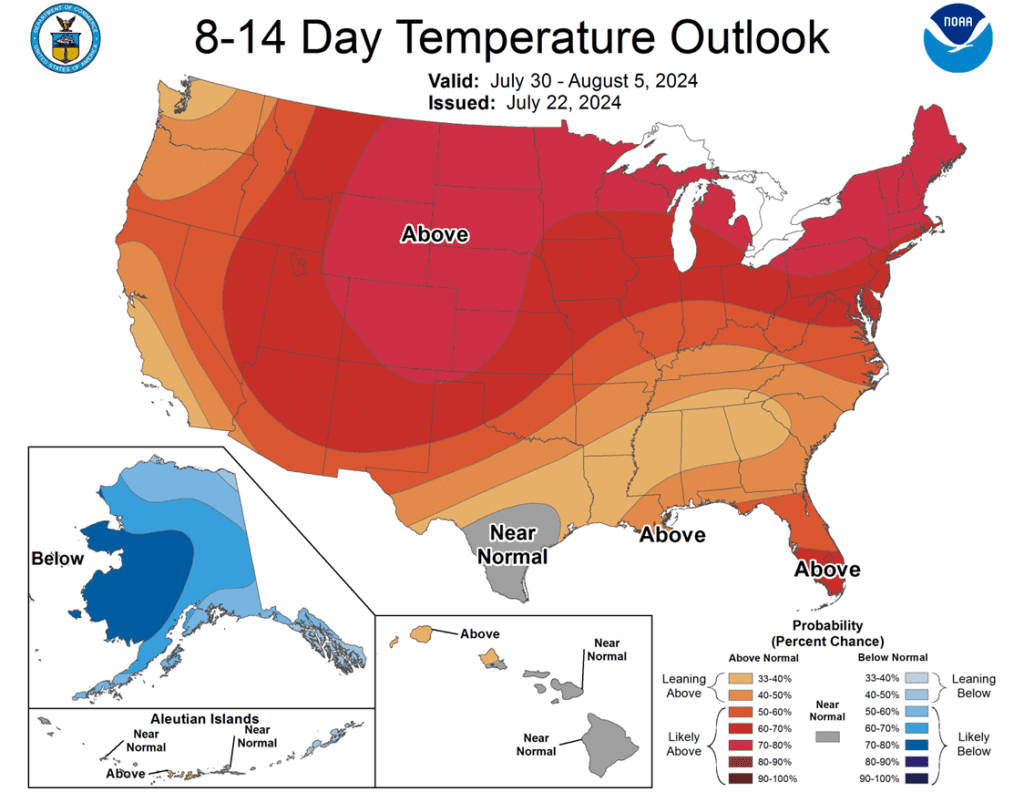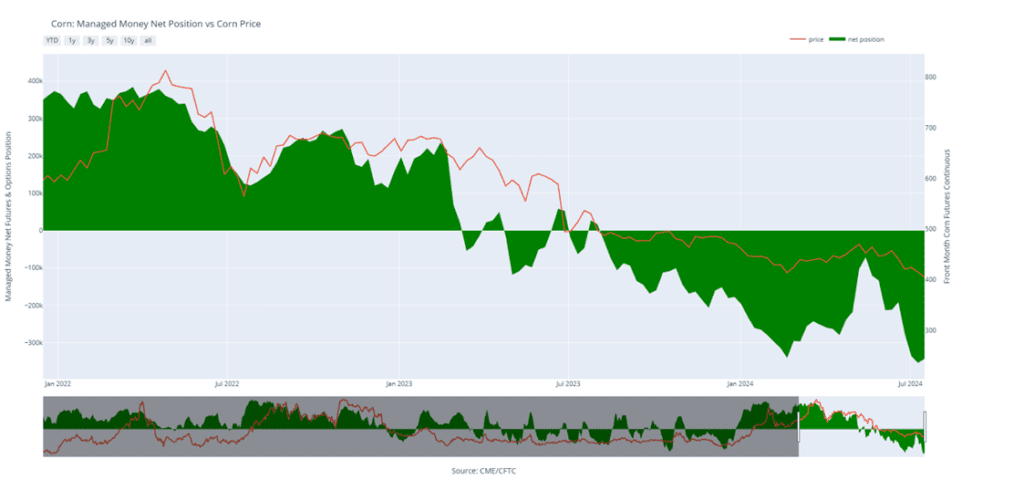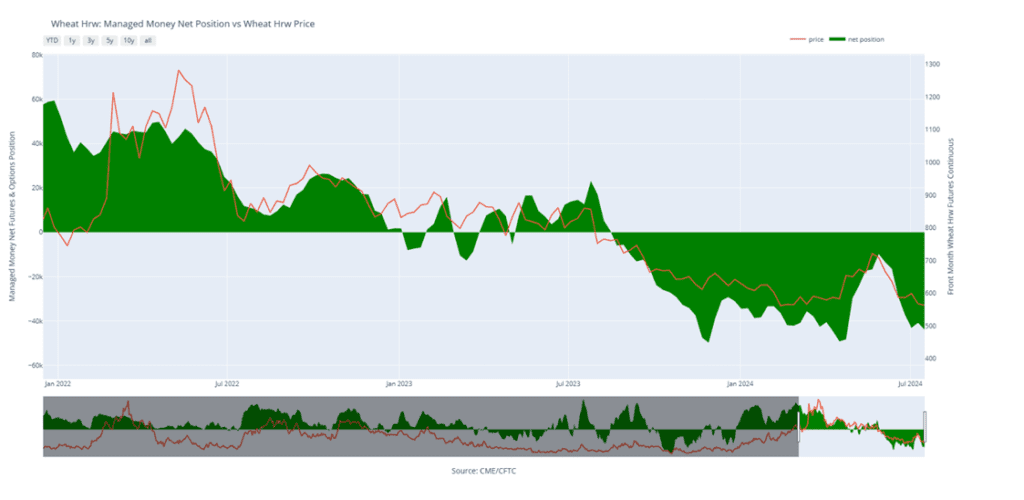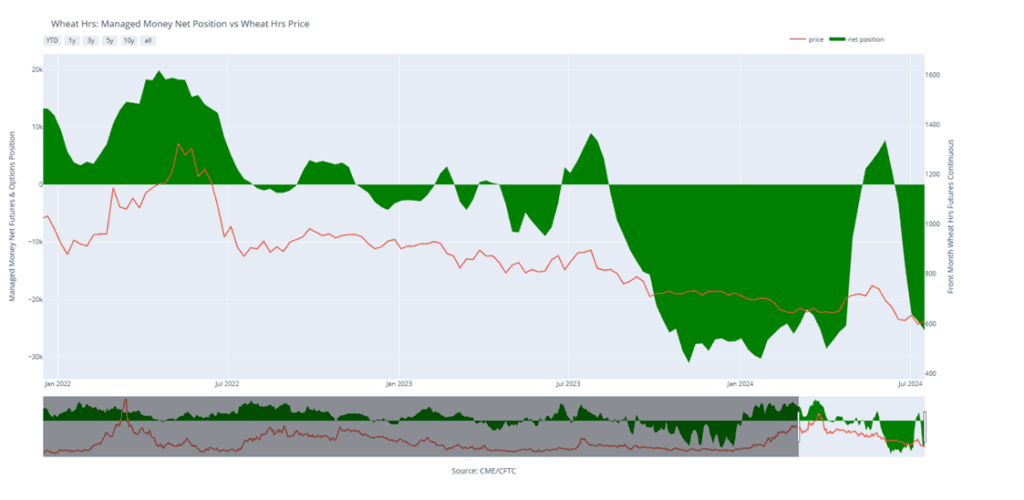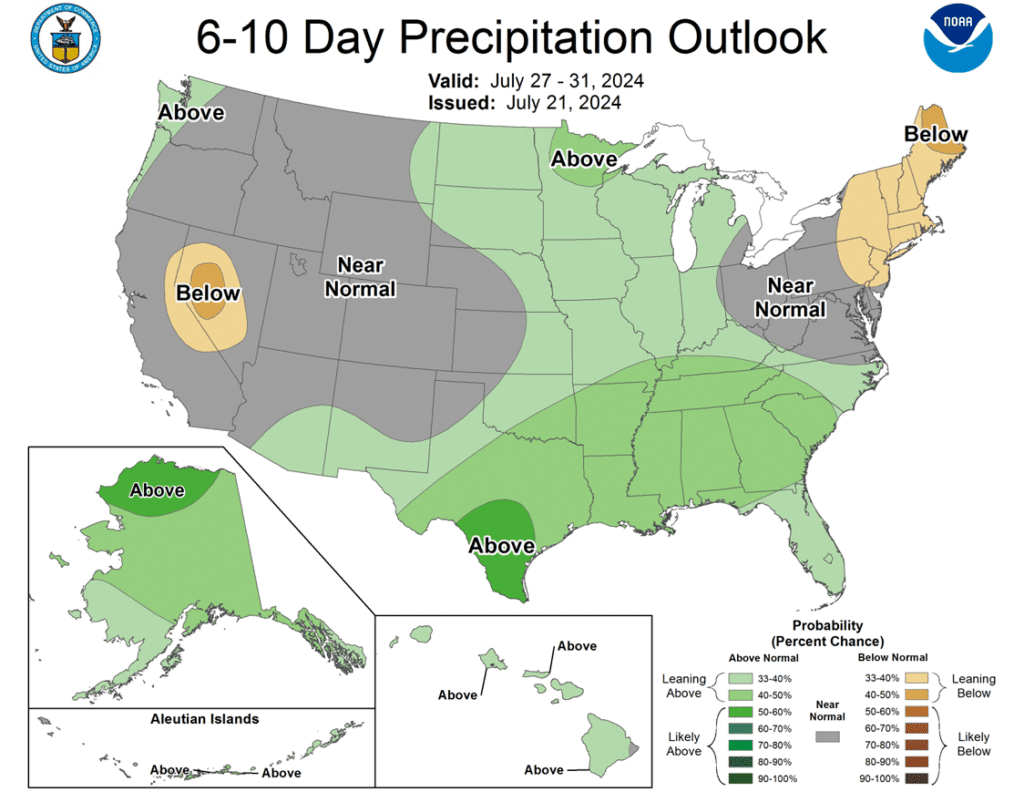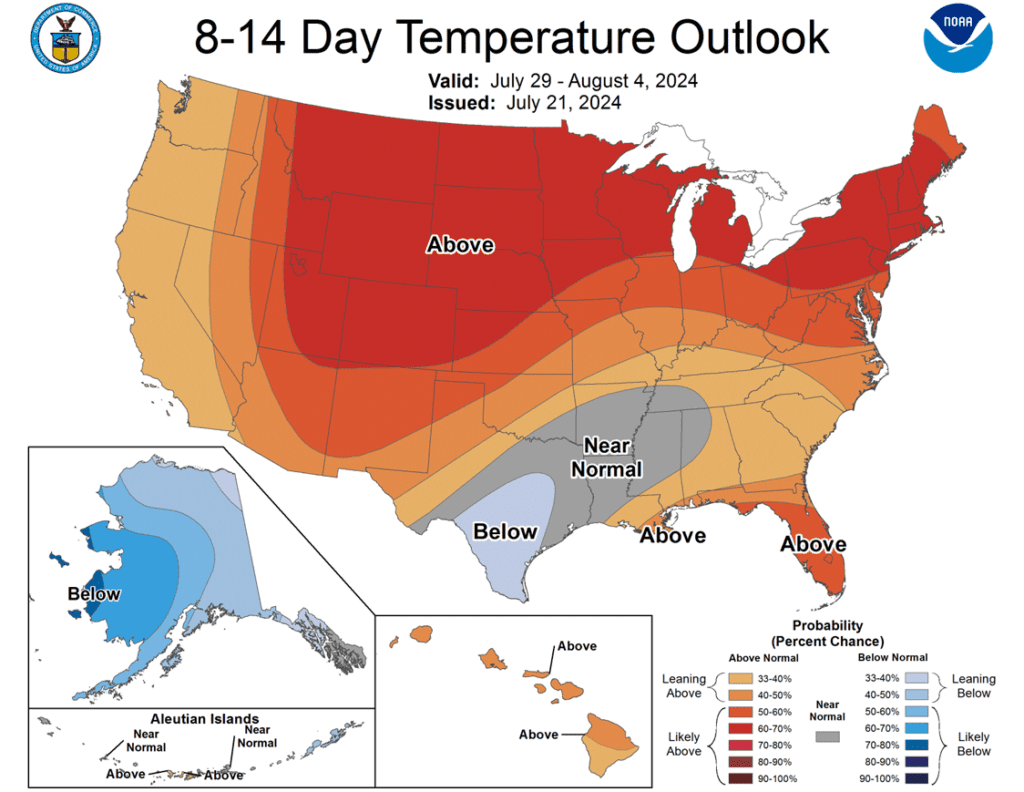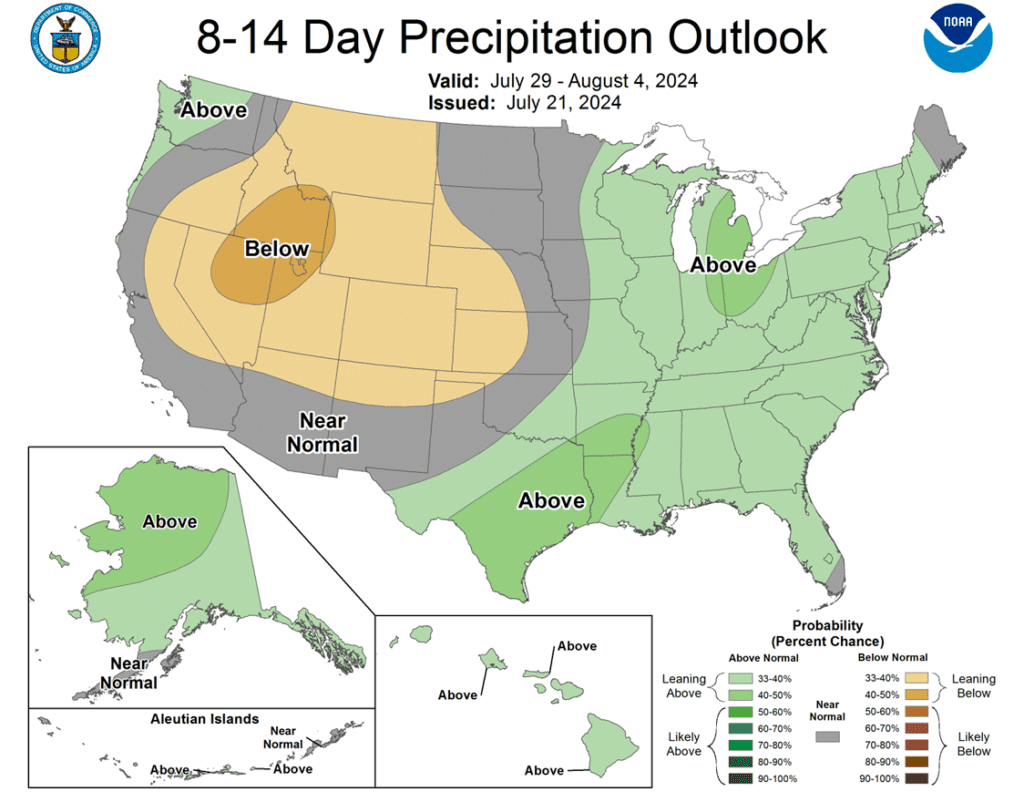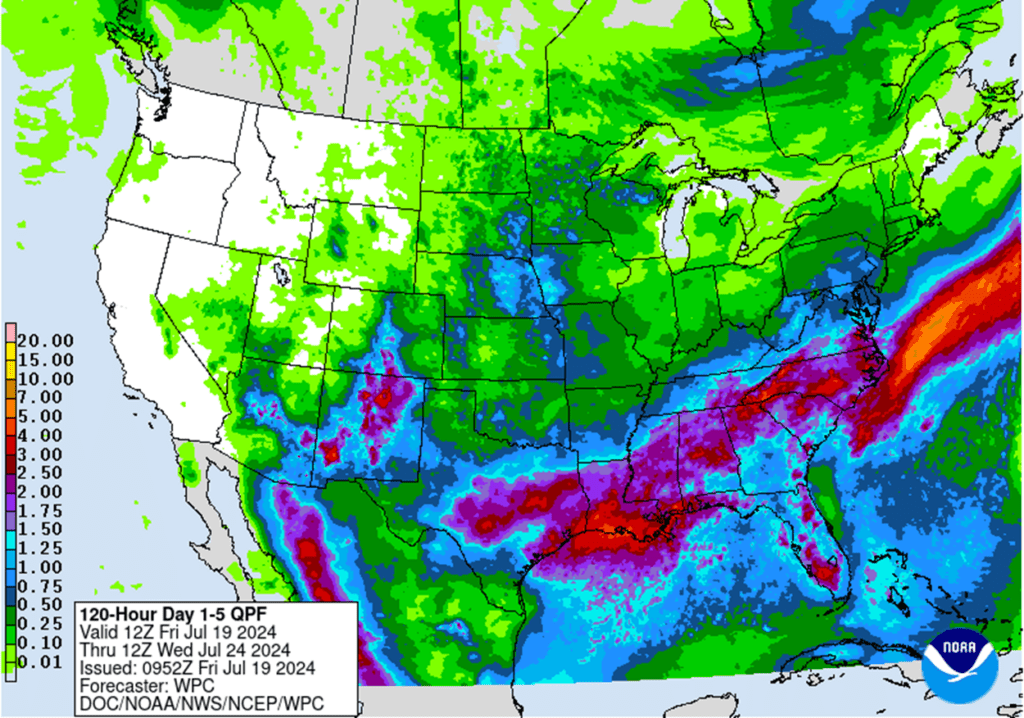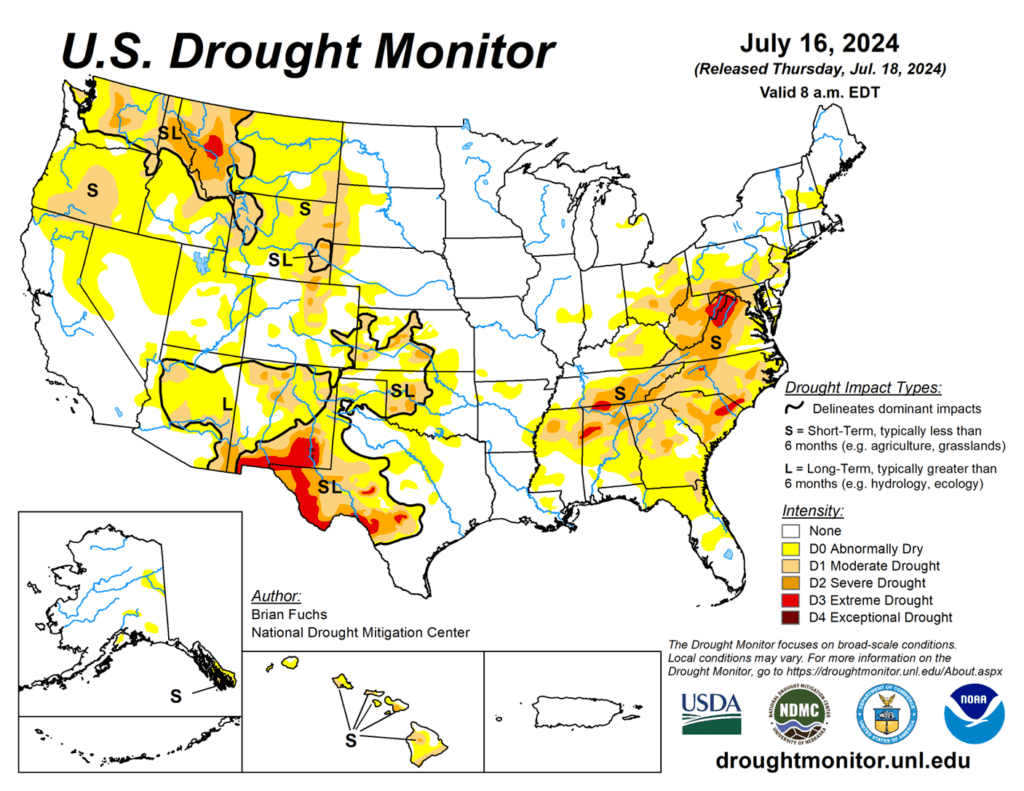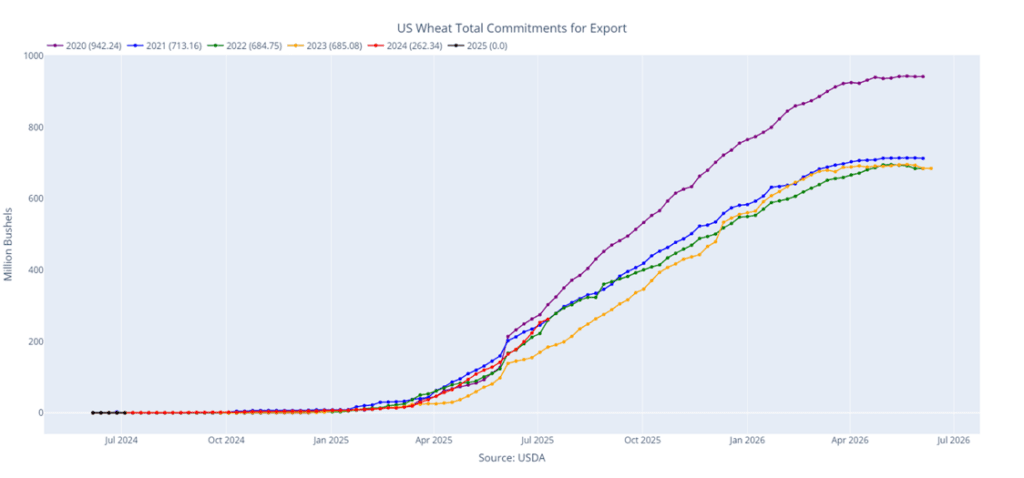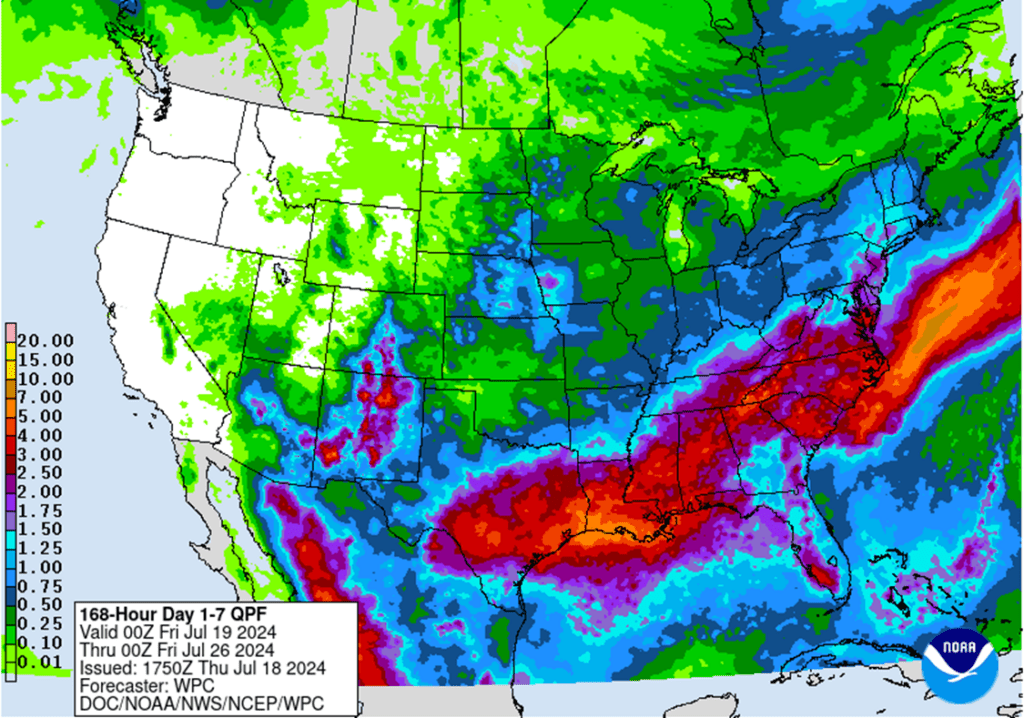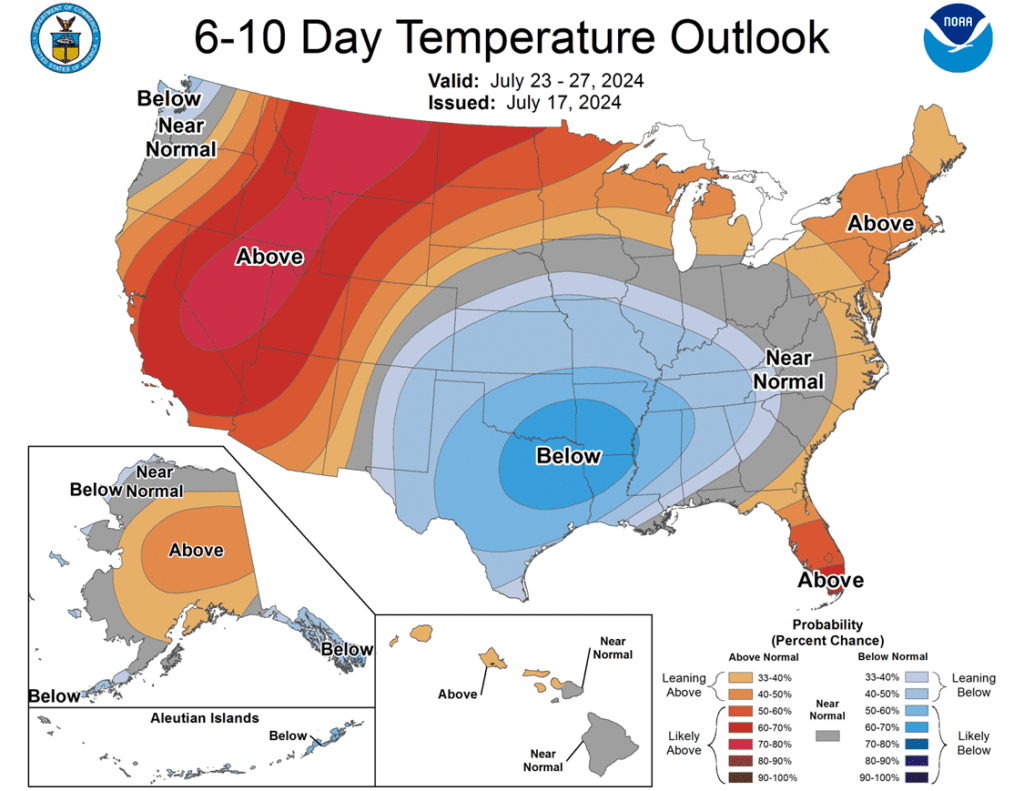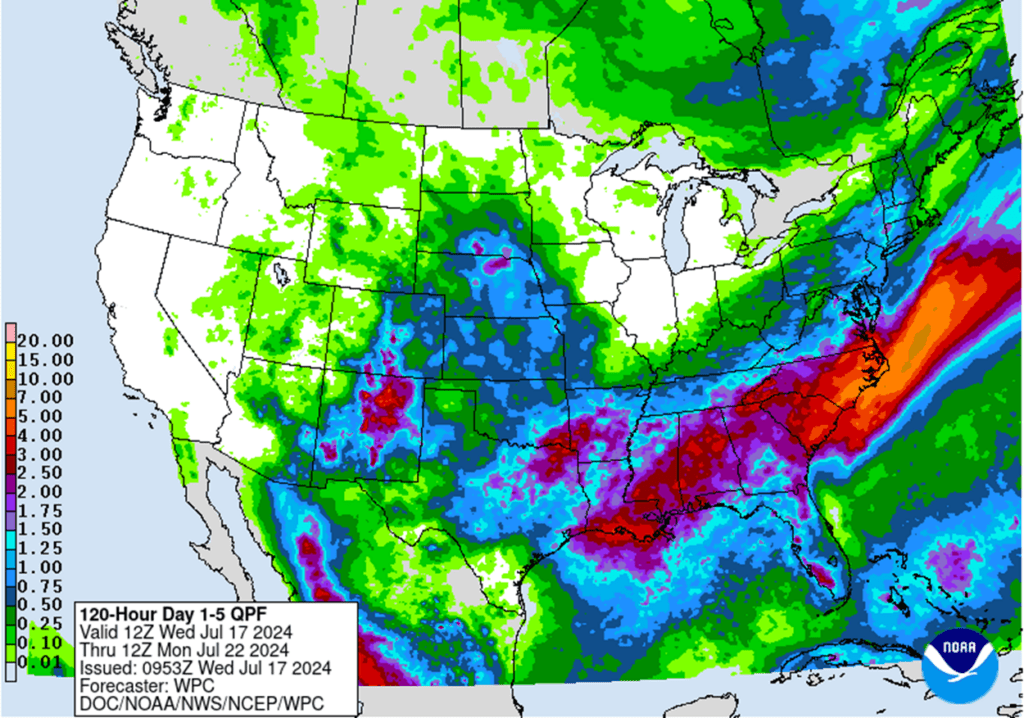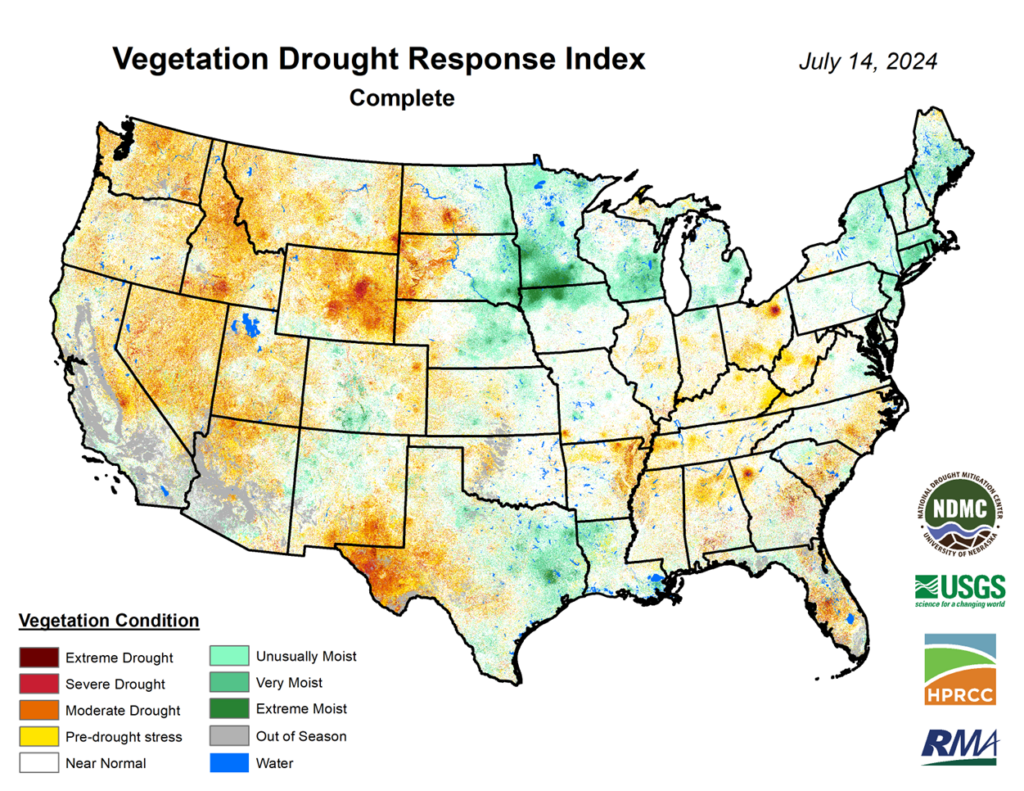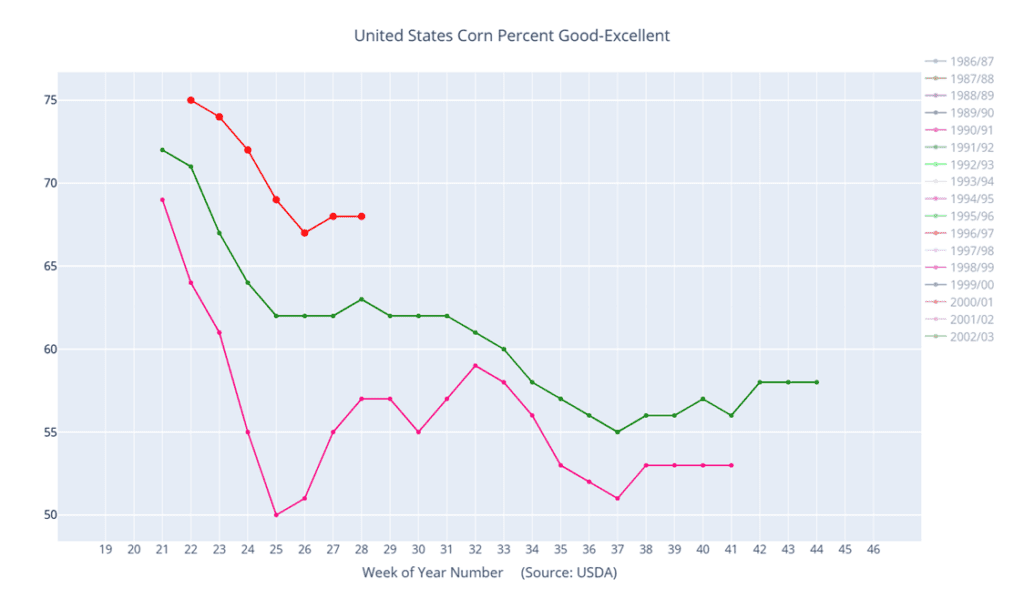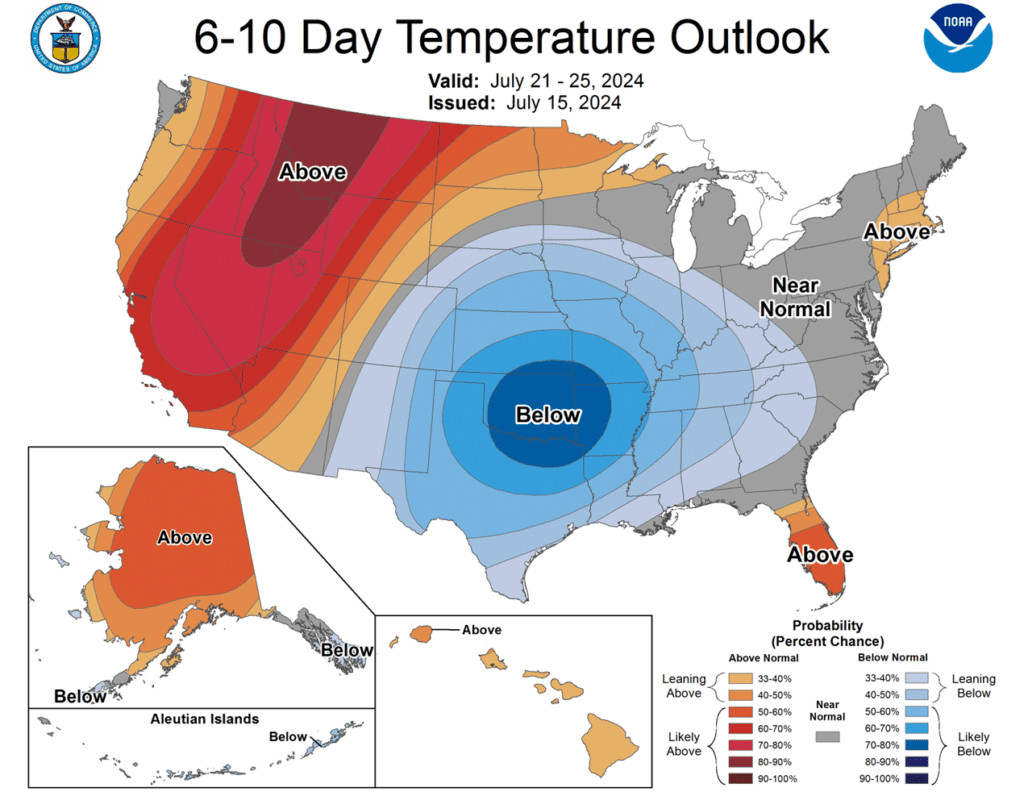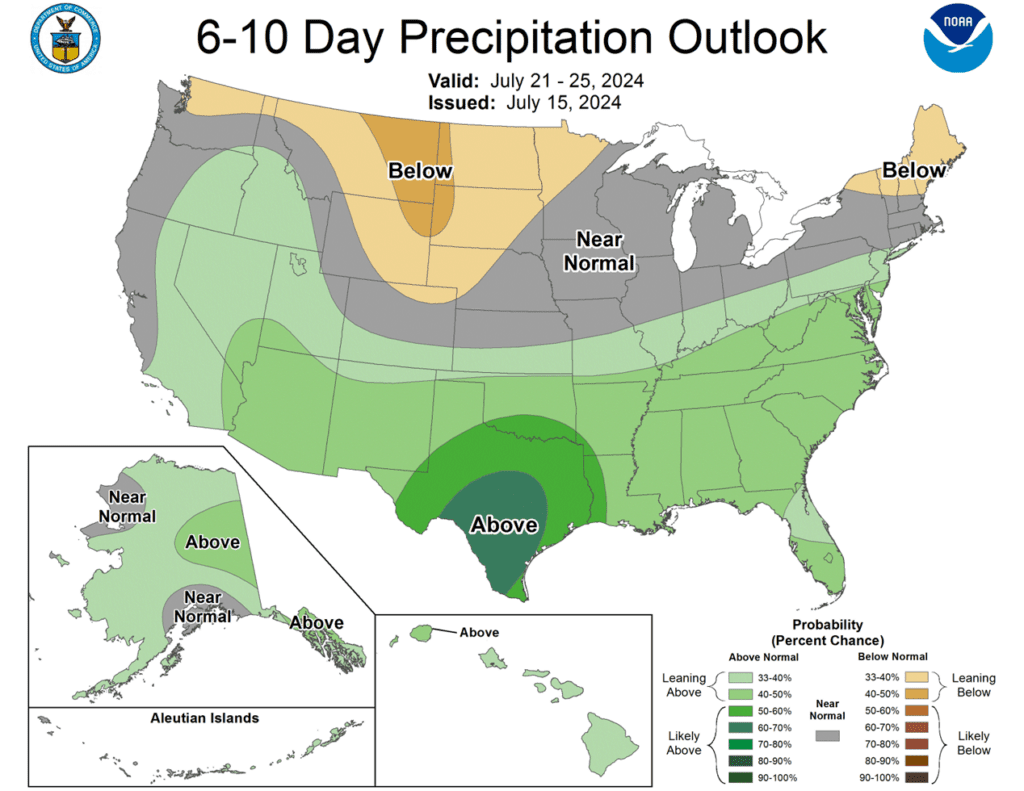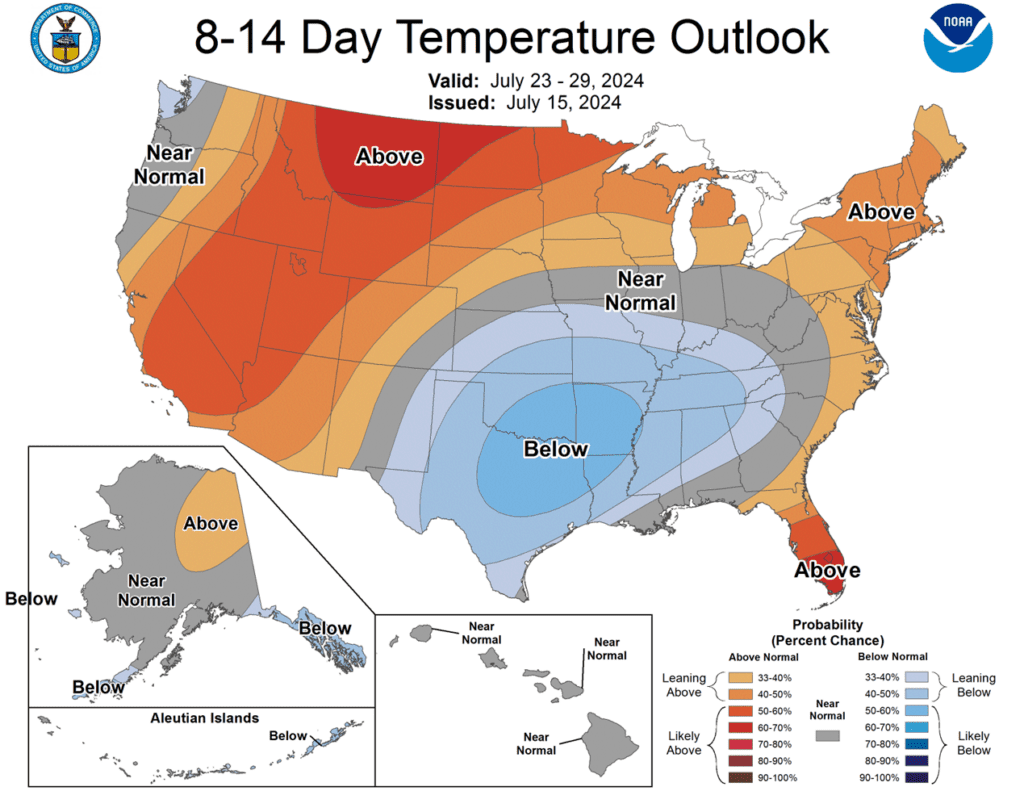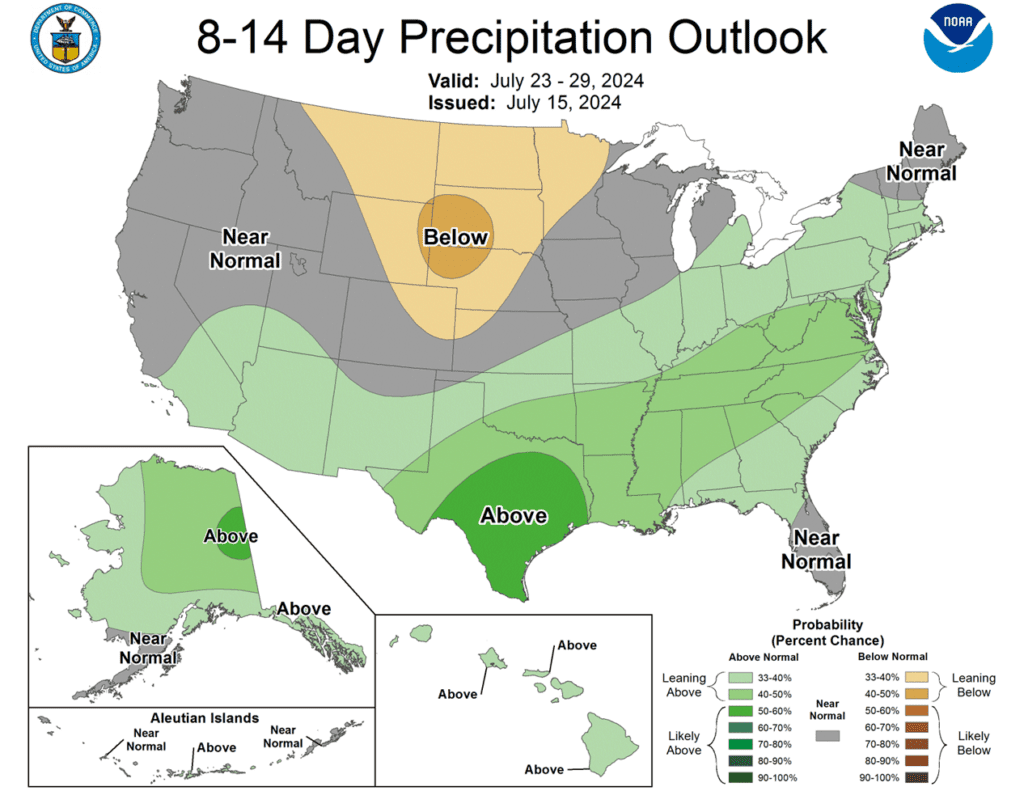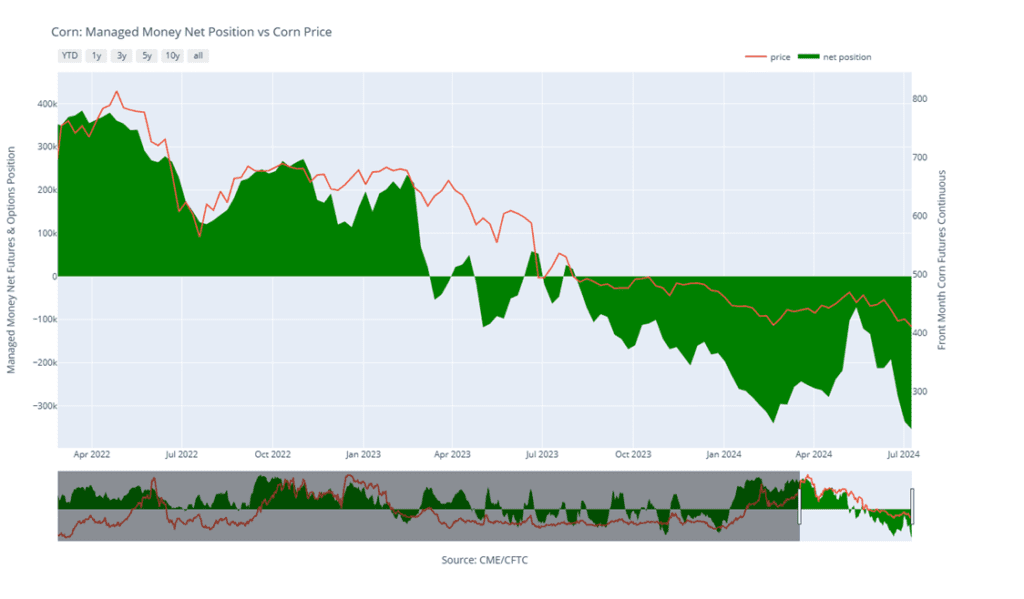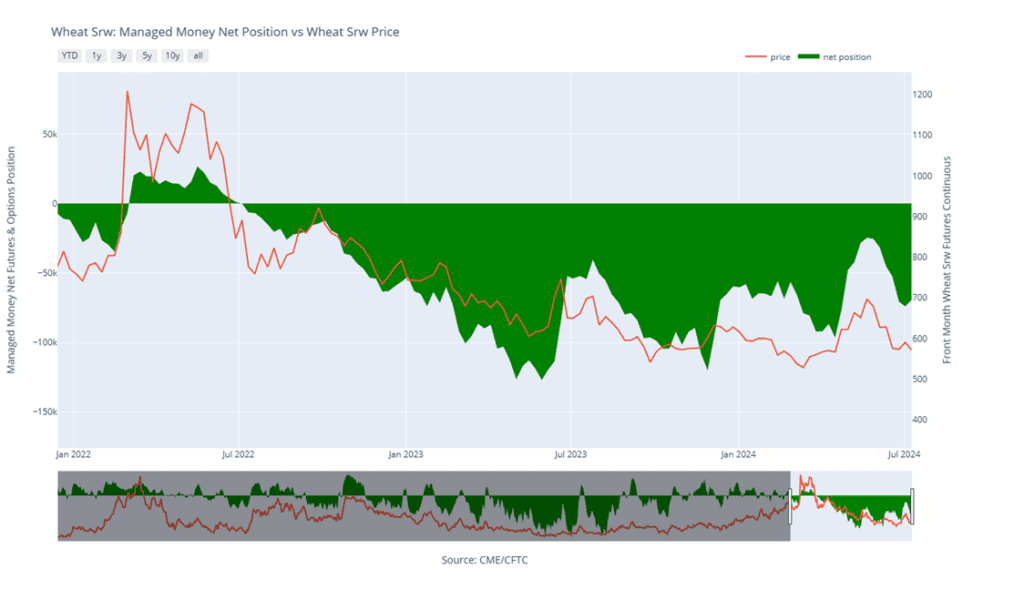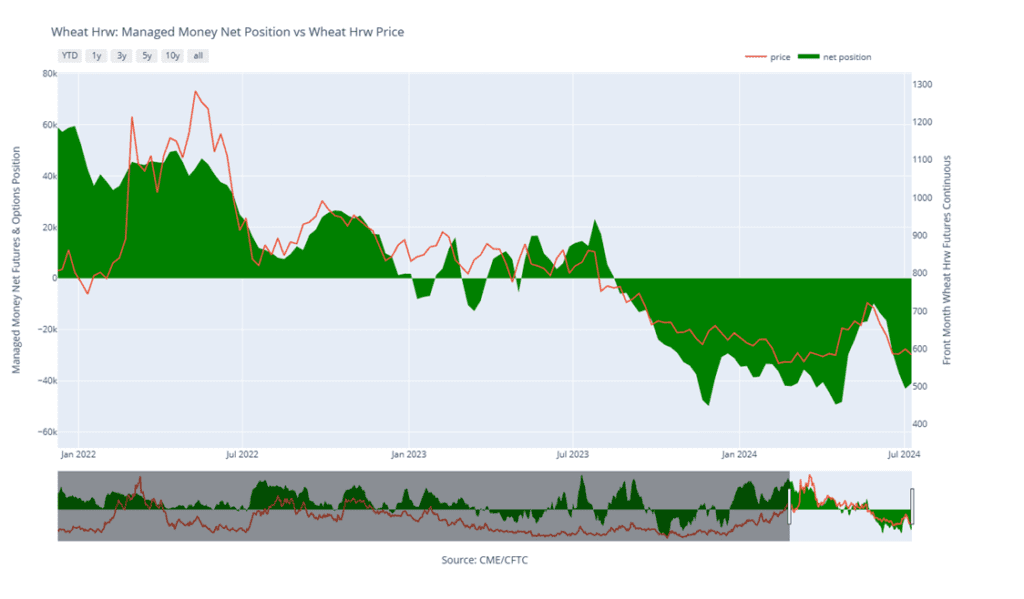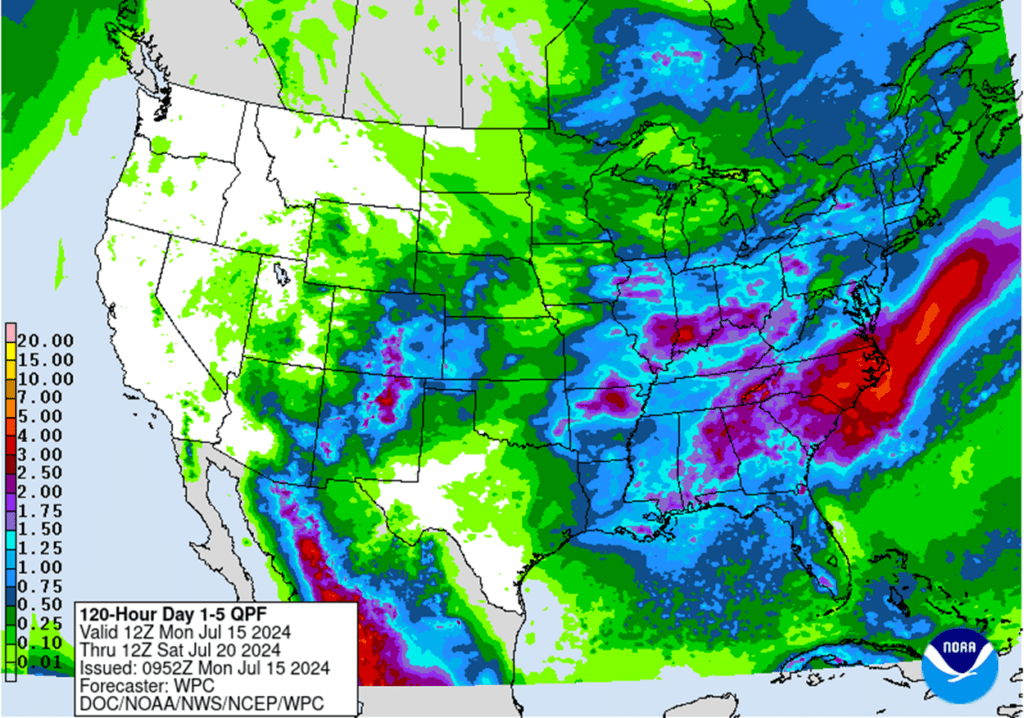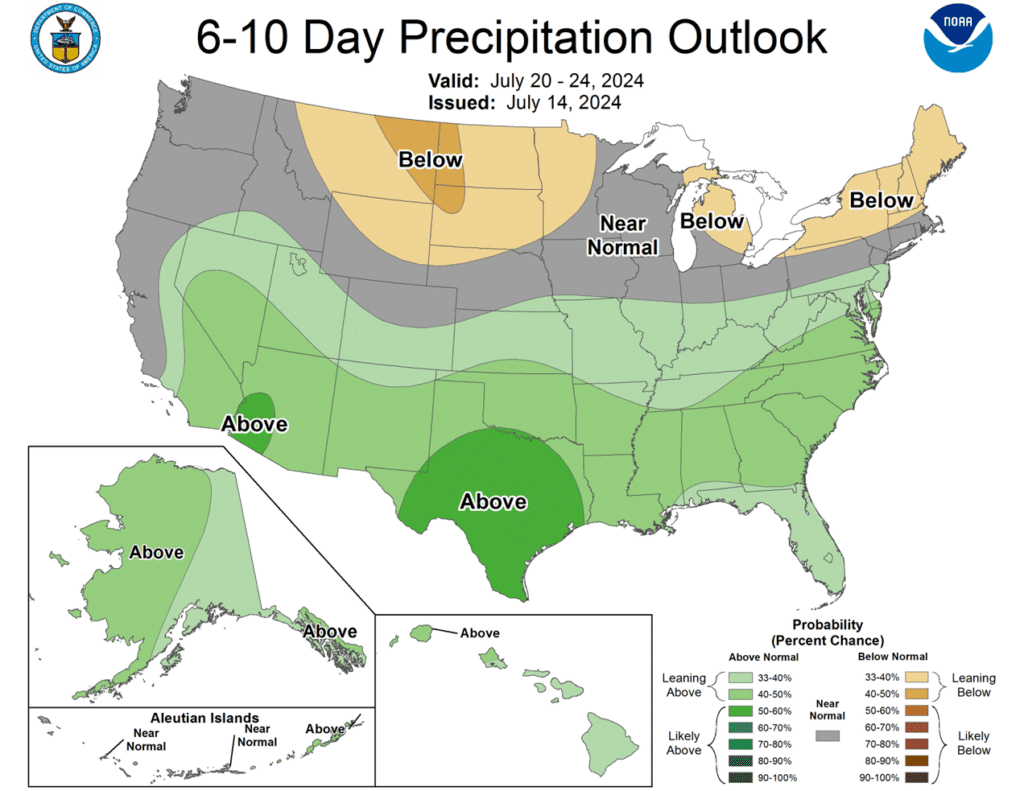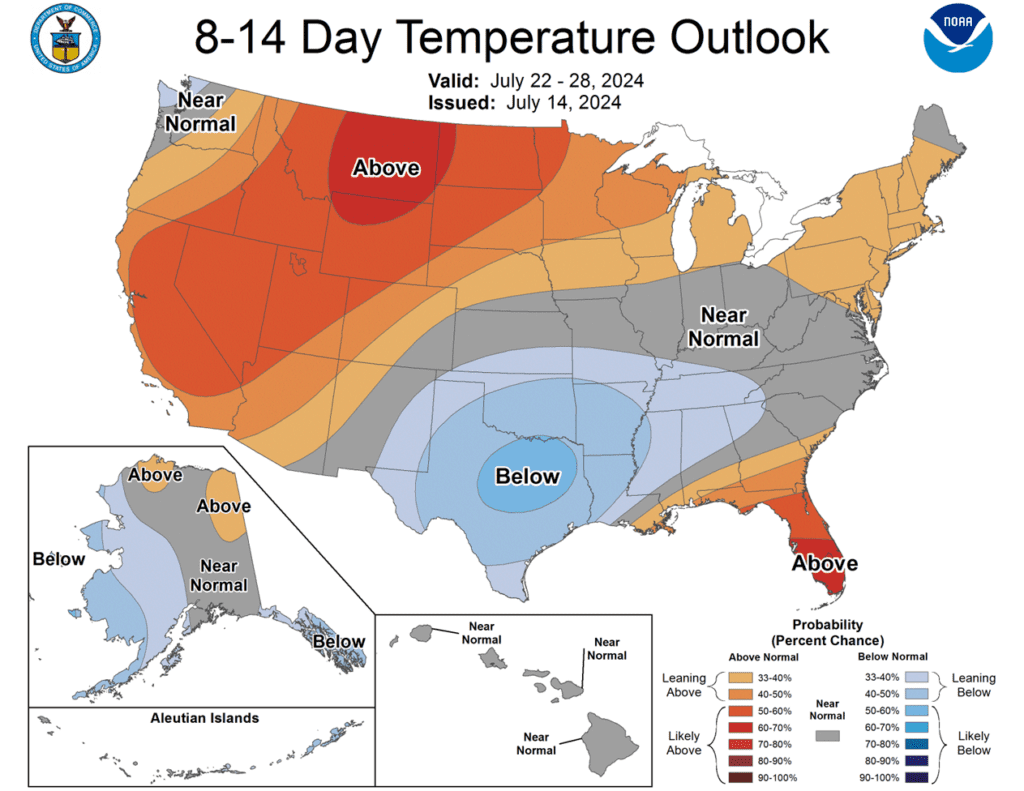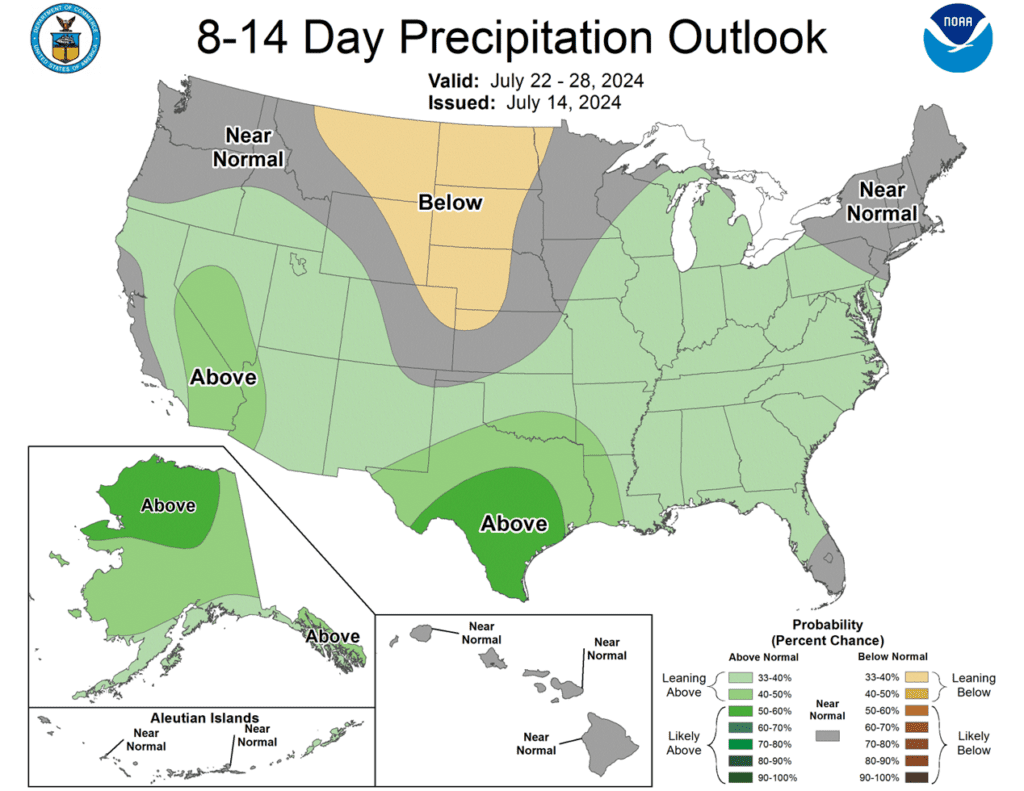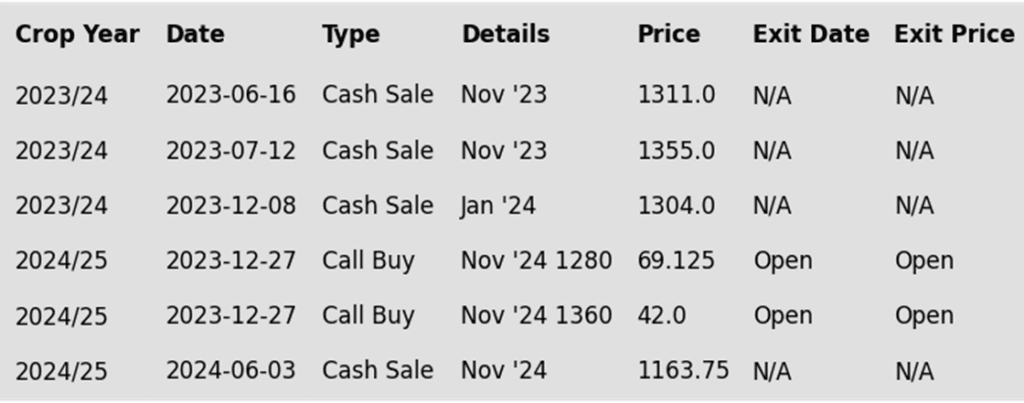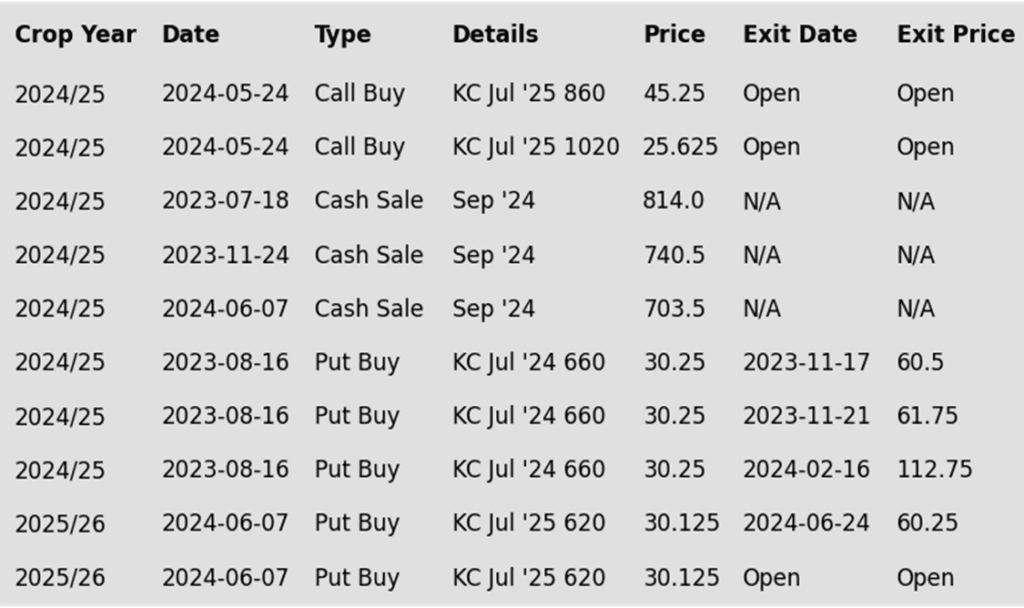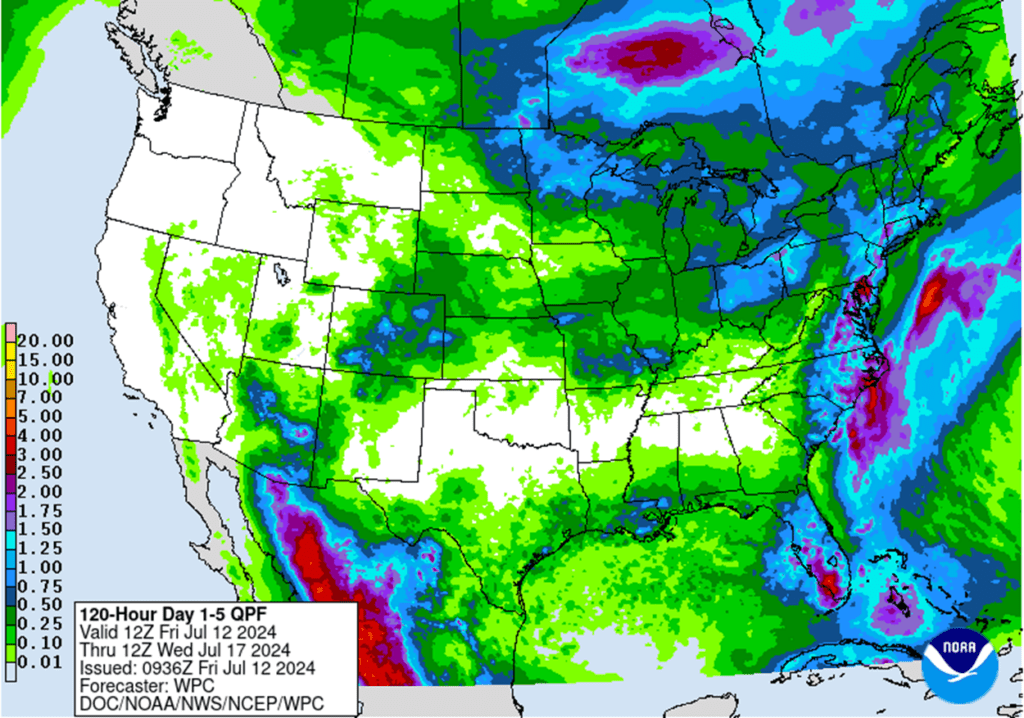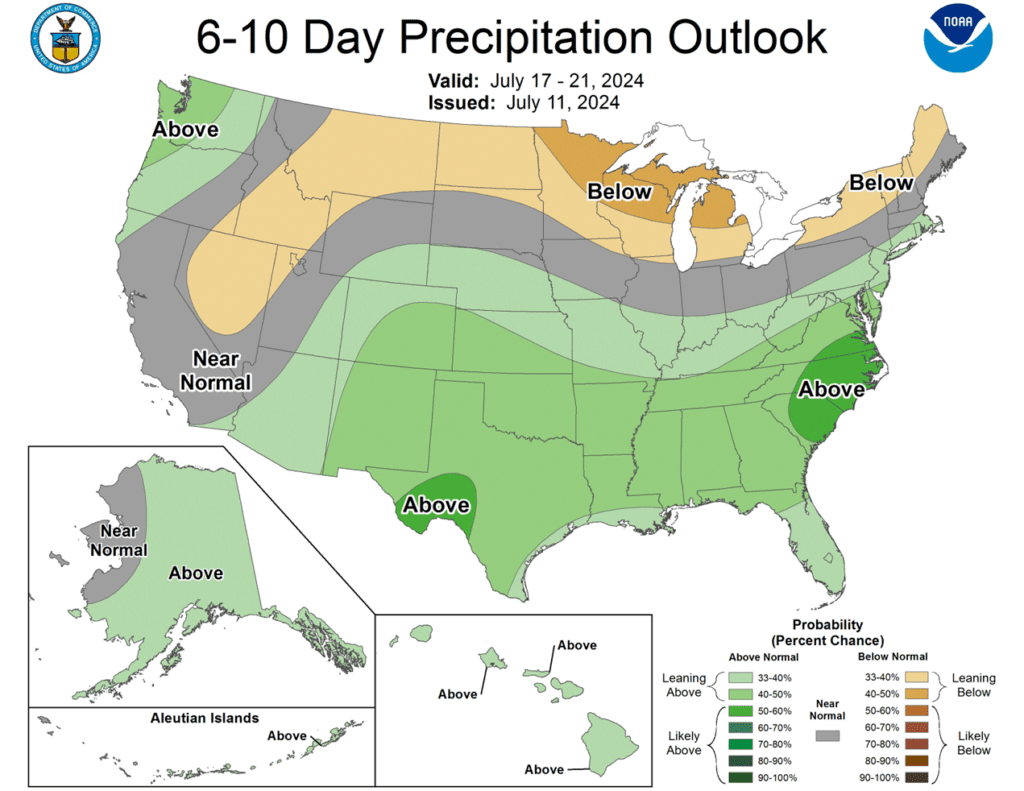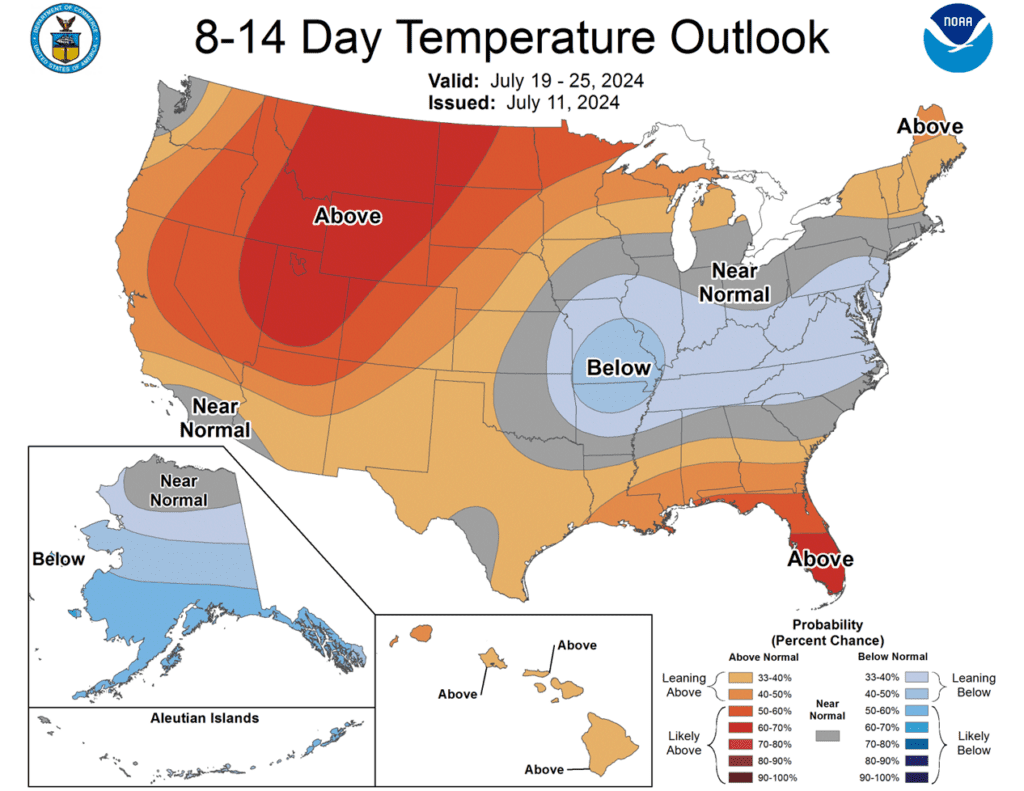7-25 End of Day: Corn and Beans Hold Their Gains, as Wheat Breaks
All prices as of 2:00 pm Central Time
Grain Market Highlights
- The corn market closed higher for the fourth consecutive day with support from new crop sales that came in at the top of expectations and carry over strength from neighboring soybeans, as traders continue to cover short positions.
- While soybean export sales fell within expectations, a flash sale for new crop soybeans to unknown destinations and soybean meal sales that exceeded expectations, helped propel new crop soybeans to double-digit gains. Soybean meal settled sharply higher across the board, while soybean oil closed mixed.
- The wheat complex experienced a down day across all three futures markets, pressured lower by continued losses in Matif wheat, and a second day of exceptional yield reports from the Spring Wheat Quality Council’s tour.
- To see the updated US 5-day precipitation forecast, 6-10 day Temperature and Precipitation Outlooks, and the updated Drought Monitor courtesy of NOAA, the Weather Prediction Center, and the NDMC scroll down to the other Charts/Weather section.
Note – For the best viewing experience, some Grain Market Insider content is best viewed with your phone held horizontally.
Corn
Corn Action Plan Summary
The USDA’s July WASDE report surprised the market by lowering 23/24 corn ending stocks below the low end of expectations resulting in a much lower than expected 24/25 ending stocks projection of 2.097 billion bushels. While this leaves new crop supplies at “adequate” levels, any increase in demand or drop in production could lead to short covering by the funds and higher prices.
- No new action is recommended for 2023 corn. Any remaining old crop 2023 corn should be getting priced into market strength. Grain Market Insider won’t have any “New Alerts” for 2023 corn – either Cash, Calls, or Puts, as we have moved focus onto 2024 and 2025 Crop Year Opportunities.
- No new action is recommended for 2024 corn. We recently recommended buying Dec ’24 470 and 510 calls after Dec ’24 closed below 451, for their relative value and because we are at that time of year of high volatility when markets can move swiftly. Moving forward, our current strategy is to target the value of 29 cents to exit the Dec ’24 470 calls. Exiting the 470 calls at 29 cents will allow you to lock in gains in case prices fall back and hold the remaining 510 calls at or near a net neutral cost, which should continue to protect existing sales and give you confidence to make further sales if the market rallies sharply. To take further action, we are targeting the 490 – 510 area to recommend making additional sales versus Dec ’24.
- Grain Market Insider sees a continued opportunity to sell a portion of your 2025 corn crop. Considering the current growing season often provides some of the best pricing opportunities for next year’s crop and given that the current heavy supply/demand picture could carry over and create upside resistance for 2025 prices, we suggest making a sale for the 2025 corn crop using either Dec ’25 futures or a Dec ’25 HTA contract, which allows the basis to be set at a more advantageous time later on.
To date, Grain Market Insider has issued the following corn recommendations:
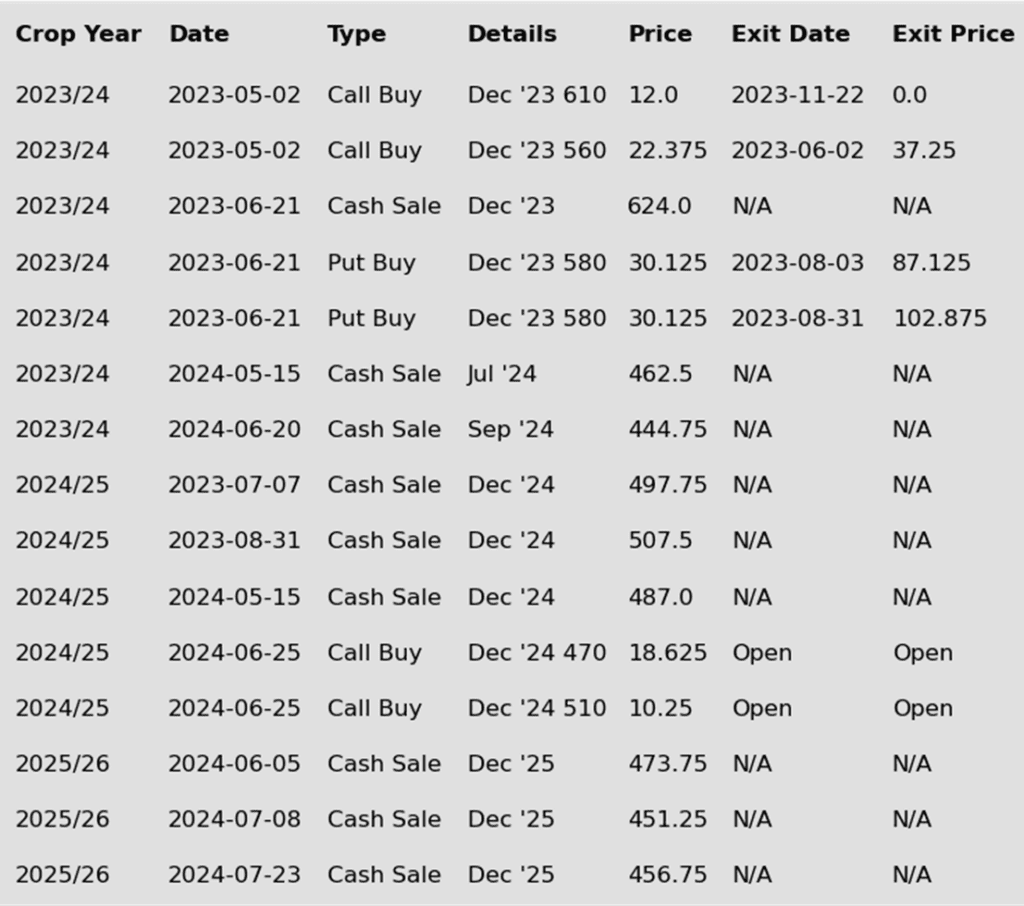
- After trading on both sides of unchanged in the overnight session, the corn market gained some footing with solid new crop export sales and carry over support from the soybean market to close in the green for the fourth day in a row.
- This week’s export sales for corn showed an increase of 13.0 mb for 23/24 and an increase of 29.3 mb for 24/25. While old crop sales were down 24% on the week and at the low end of trade expectations, new crop sales came in at the top end of expectations and lent support to the deferred contracts.
- Last week’s export shipments of 47.6 mb exceeded the 42.2 million bushels needed each week to meet the USDA’s export estimates. The primary destinations were Mexico, South Korea, and Japan.
- LSEG Ag Research updated its estimate of Brazil’s 23/24 total corn production as the safrinha corn harvest begins to wrap up, raising it 1% to 120.1 mmt. This compares to CONAB at 115.9 mmt and the USDA’s latest estimate of 122 mmt.
- As we enter the end of July, weather forecasts are turning less friendly for crop development for the first part of August as temperatures look to trend well above average, with near term above normal moisture in the ECB turning drier, along with below normal moisture in the WCB. While most of the corn crop is in overall good condition, weather will still play a key role in finishing the crop into harvest.

Above: The corn market continues to consolidate as it corrects from being oversold. If prices break out above the 404 – 415 resistance area, they could run toward 425 – 430. To the downside, a break below 391 could suggest a further decline towards the 362 – 360 area.
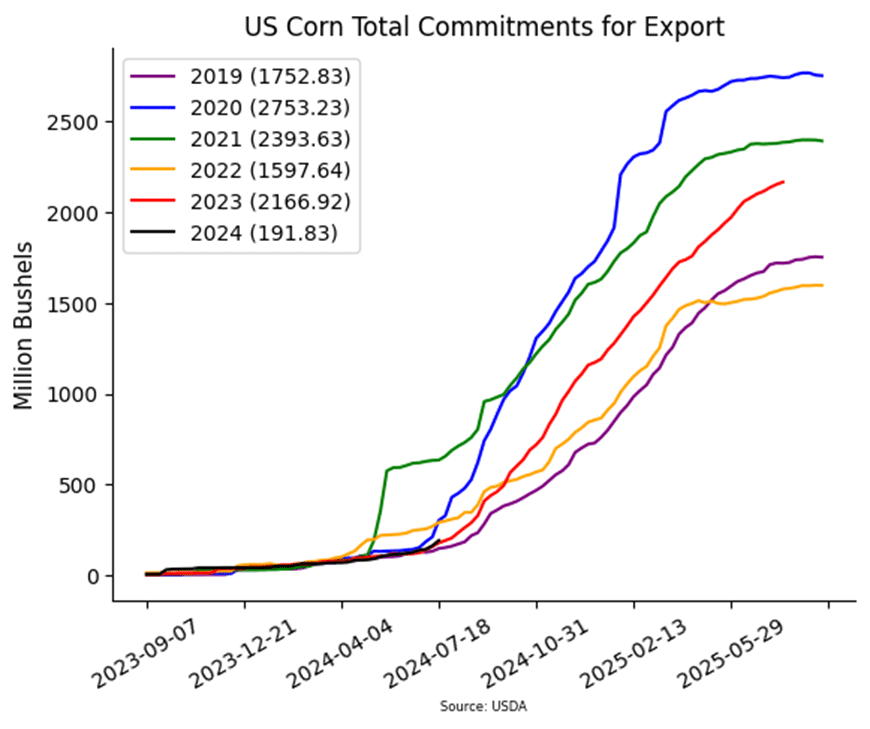
Soybeans
Soybeans Action Plan Summary
Weighed down by sluggish export demand and favorable weather, the soybean market experienced a choppy downward trajectory leading up to the USDA’s July WASDE report. While the USDA lowered old crop ending stocks more than expected, resulting in a larger-than-anticipated drop in new crop carryout projections, the 435 mb projected carryout remains a bearish factor given the current demand picture. With much of the growing season still ahead, the lower anticipated supply leaves less margin for error if growing conditions turn hot and dry. For now, a weather-related issue or a surge in demand appears to be the most likely catalyst to push prices higher.
- No new action is recommended for 2023 soybeans. Any remaining old crop 2023 soybeans should be getting priced into market strength. Grain Market Insider won’t have any “New Alerts” for 2023 soybeans – either Cash, Calls, or Puts, as we have moved focus onto 2024 and 2025 Crop Year Opportunities.
- No new action is recommended for the 2024 crop. At the end of December, we recommended buying Nov ’24 1280 and 1360 calls due to the amount of uncertainty in the 2024 soybean crop and to give you confidence to make sales and protect those sales in an extended rally. Given that the market has retreated since that time, we are targeting the mid-1100s versus Nov ’24 futures to exit 1/3 of the 1280 calls to help preserve equity. Most recently we employed our Plan B strategy with the close below 1180 in Nov ’24 and recommended making additional sales due to the potential change in trend. With much of the growing season still ahead of us, should the market turn back higher, we are targeting the upper 1100s to low 1200s from our Plan A strategy to potentially make two additional sales recommendations.
- No Action is currently recommended for 2025 Soybeans. We currently aren’t considering any recommendations at this time for the 2025 crop that will be planted next year, and it may be some time before conditions are conducive to consider making any recommendations. Be patient as we monitor the markets for signs of improvement.
To date, Grain Market Insider has issued the following soybean recommendations:
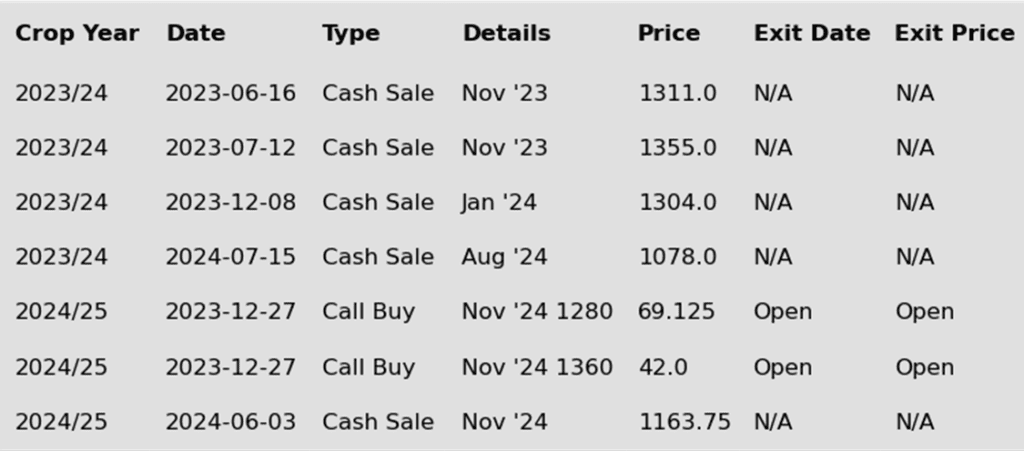
- Soybeans ended the day higher for the third time this week with November futures now up 43 ½ cents since Monday. Today’s Export Sales report was not particularly friendly, but a flash sale was reported this morning to unknown destinations. Soybean meal led the complex higher today with the September contract up 2.48%. Soybean oil was mixed with the front months lower and deferred months higher.
- Today’s export sales report saw an increase of 3.3 mb of soybean export sales in 23/24 and an increase of 30.5 mb for 24/25. This was within the range of estimates, but sales for 23/24 were down 61% from the previous week and 63% from the prior 4-week average. Last week’s export shipments of 13.5 mb were below the 15.9 mb needed each week to meet the USDA’s estimate, and primary destinations were to the Netherlands, Mexico, and Indonesia.
- While soybean sales were on the softer side this week, sales of soybean meal were very strong which explains today’s big gains in meal futures. 258,100 mt of old crop meal and 520,900 mt of new crop meal were sold last week with the Philippines showing up as the largest buyer of old crop while the new crop purchases were made by unknown buyers.
- The weather has been beneficial up until this point, but forecasts are turning dry and very hot heading into August which will be crucial for pod fill. Little impact is expected this week, but the GFS model shows temperatures potentially reaching as high as 113 degrees in some parts of the Midwest.

Above: September soybeans appear to have found initial support just below the market around 1054. Should this area hold, and prices close above 1082 ¼, they could run toward 1130 – 1170 congestion area, though they may encounter resistance near 1100. A break below 1054 could put the market at risk of retreating toward the July low of 1030 ¼, where further support may be found.
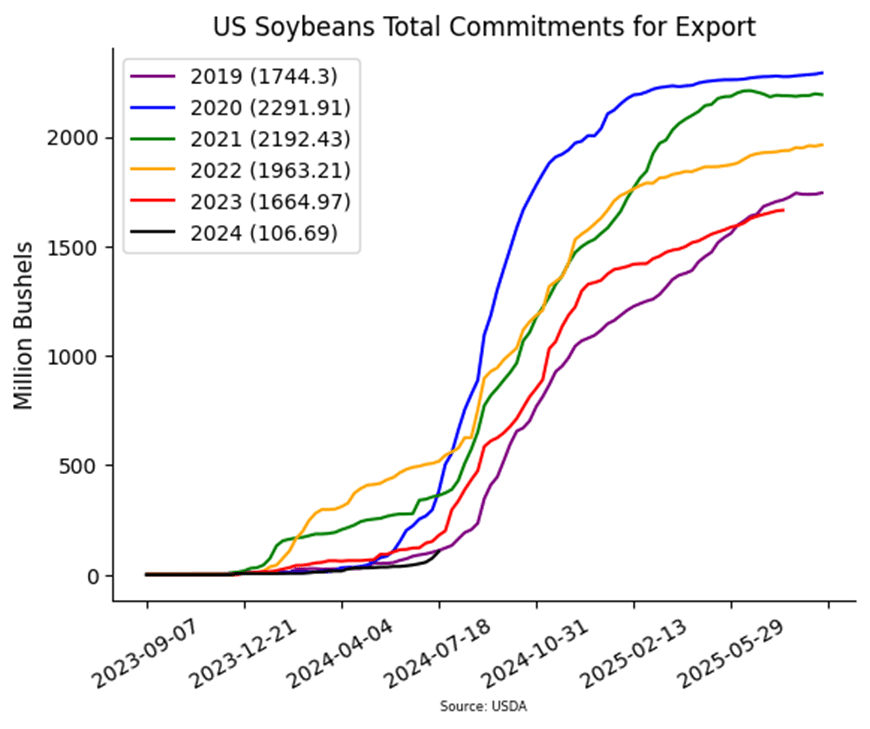
Wheat
Market Notes: Wheat
- Wheat closed lower across all three categories, led by Chicago futures. Continued losses in Paris milling wheat futures provided no support, and US wheat struggled to find footing despite higher corn and soybean prices.
- The USDA reported an increase of 11.4 mb in wheat export sales for 24/25. Shipments last week at 10 mb fell below the 16.0 mb pace needed per week to reach the export goal of 825 mb. Sales commitments so far are at 295 mb for 24/25 which is up 48% year on year.
- Day two of the Spring Wheat Quality Council’s wheat tour again found promising conditions. In north central North Dakota, they found a yield potential of 53.7 bpa, compared with 45.7 bpa last year. However, it was noted that some head blight was present which could affect final yields.
- According to the USDA, drought is increasing in spring wheat areas. As of July 23, 15% of US spring wheat crop acres were experiencing drought, compared to 12% the week prior. The heat and dryness in parts of Canada and the US northern Plains could affect final spring wheat yields.
- As reported by the International Grains Council, FOB export values increased in the US and Europe but fell in Russia to $219 per mt, which keeps Russia the export leader for now. It is worth noting that US SRW wheat has become more competitive and is at a $21 per mt discount when compared with French FOB offers.
Chicago Wheat Action Plan Summary
Since rallying nearly 200 cents from the March low to the May high, largely on fund short covering from Russian crop concerns and dryness in the southwestern Plains, prices have fallen from their peak with seasonal weakness and a quick harvest pace. Although prices remain weak, the market shows signs of being oversold, which can be supportive in the event prices turn back higher, while the breakout above the December highs suggests there is potential for a test of the 2023 summer highs post-harvest.
- No new action is recommended for 2024 Chicago wheat. Considering the recent rally in wheat, we recommended taking advantage of the elevated prices to make additional sales and buy upside July ’25 860 and 1020 calls (for their extended time frame) in case of a protracted rally. Our current strategy is to target 740 – 760 versus Sept ’24 to recommend further sales and to target a selling price of about 73 cents in the 860 calls to achieve a net neutral cost on the remaining 1020 calls. The remaining 1020 calls would then continue to protect existing sales and give you confidence to make additional sales at higher prices.
- No new action is currently recommended for 2025 Chicago Wheat. Our most recent recommendation was to exit half of the previously recommended July ’25 Chicago 620 puts once they reached 67 cents (approximately double their original cost), to lock in gains in case the market rallies back. Moving forward, our strategy is to hold the remaining July ’25 620 puts at, or near, a net neutral cost to maintain downside coverage for any unsold bushels, while also targeting the 620 – 640 range to recommend making additional sales.
- No action is currently recommended for 2026 Chicago Wheat. We currently aren’t considering any recommendations at this time for the 2026 crop that will be planted next year, and it may be some time before conditions are conducive to consider making any recommendations. Be patient as we monitor the markets for signs of improvement.
To date, Grain Market Insider has issued the following Chicago wheat recommendations:
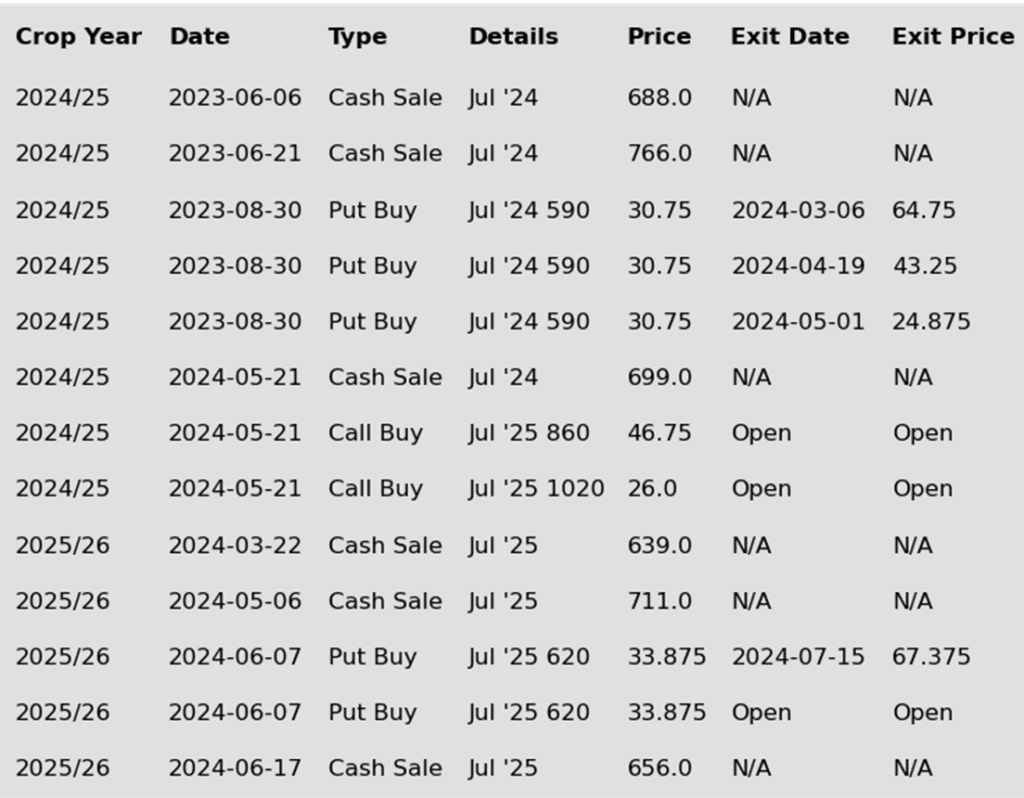

Above: The consolidation of the Chicago wheat market shows support below the market around just above the March 523 ½ low. Should the market continue higher, upside resistance could be found between 555 and 580, with additional resistance between 590 and 600. While a close below 523 ½ could suggest a lower trend towards 500 psychological support, with further support in the 490 – 470 area.
KC Wheat Action Plan Summary
Since the end of May the wheat market has been trending lower as concerns regarding Russia’s shrinking wheat crop have waned, and US HRW harvest yields have been higher than expected. During this time managed funds started reestablishing their short positions while the market continues to show signs of being oversold. While harvest pressure and falling Black Sea export prices continue to weigh on US prices, the funds’ short position and oversold conditions could culminate in a short covering rally on any increase in demand as world wheat ending stocks are expected to fall yet again this year.
- No new action is recommended for 2024 KC wheat. Considering the recent upside breakout in KC wheat, we recommended buying upside July ’25 860 and 1020 calls (for their extended time frame) in case of a protracted rally. Our current strategy is to target 725 – 750 versus Sept ’24 to recommend further sales and to target a selling price of about 71 cents on the 860 calls to achieve a net neutral cost on the remaining 1020 calls. The remaining 1020 calls would then continue to protect existing sales and give you confidence to make additional sales at higher prices.
- No new action is currently recommended for 2025 KC Wheat. We recently recommended exiting half of the previously recommended July ’25 620 puts once they reached 60 cents (double the original approximate cost) to realize gains in case the market rallies back, while still holding the remaining 620 puts at, or near, a net neutral cost for continued downside coverage on any unsold bushels. Looking ahead, our strategy is to target the 680 – 710 range to recommend making additional sales.
- No action is currently recommended for 2026 KC Wheat. We currently aren’t considering any recommendations at this time for the 2026 crop that will be planted next year, and it may be some time before conditions are conducive to consider making any recommendations. Be patient as we monitor the markets for signs of improvement.
To date, Grain Market Insider has issued the following KC recommendations:


Above: After finding support just below 550, KC wheat prices could continue higher and encounter resistance near 600, as they move towards the 634 – 654 resistance area. A reversal lower, and a break below 545 could find further support in the 530 area.
Mpls Wheat Action Plan Summary
Since the end of May, the wheat market has been in a down trend as concerns about Russia’s shrinking wheat crop have eased and the US winter wheat crop exceeded expectations. During this period, managed funds reestablished their short positions in Minneapolis wheat. Though declining Russian export prices continue to keep a lid on US prices, smaller crops in Europe and the Black Sea region could increase US demand, potentially triggering a short-covering rally with the fund’s newly reestablished short position, especially as global wheat ending stocks are projected to decline again this year.
- No new action is recommended for 2023 Minneapolis wheat. Any remaining 2023 spring wheat should be getting priced into market strength. Grain Market Insider won’t have any “New Alerts” for 2023 Minneapolis wheat – either Cash, Calls, or Puts, as we have moved focus onto 2024 and 2025 Crop Year Opportunities.
- No new action is recommended for 2024 Minneapolis wheat. With the recent close below the 712 support level, Grain Market Insider implemented its Plan B stop strategy, recommending additional sales for the 2024 crop due to waning upside momentum and an increased likelihood of a downward trend. Given the heightened volatility and the amount of time that remains to market this crop, we will maintain the current July ’25 KC wheat 860 and 1020 call options. Our target is a selling price of about 71 cents for the 860 calls to achieve a net neutral cost on the remaining 1020 calls. These 1020 calls will continue to protect existing sales and provide confidence to make additional sales at higher prices.
- Grain Market Insider sees a continued opportunity to sell another portion of your anticipated 2025 spring wheat production. Since our last sales recommendation for the 2025 spring wheat crop, September ’25 Minneapolis wheat has rallied about 30 cents off its recent low and reached our upside target as it approaches the congestion and resistance area from early July. Considering this time of year can provide some of the best opportunities to get early sales on the books for next year, Grain Market Insider recommends taking advantage of this rally to sell another portion of your anticipated 2025 spring wheat crop using either Sept ’25 futures or a Sept ’25 HTA contract, so that basis can be set at a more advantageous time later on.
To date, Grain Market Insider has issued the following Minneapolis wheat recommendations:
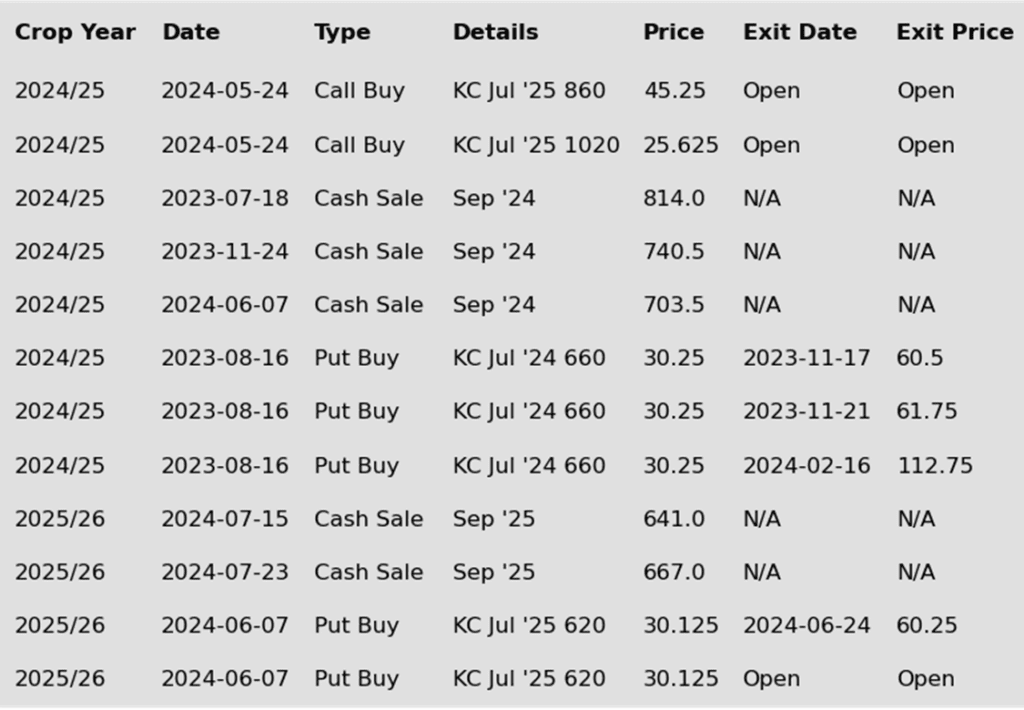

Above: After encountering resistance near 630, the market reversed lower and could be on track toward the July low near 575, where it should find support. A close below 575 puts the market at risk of drifting lower toward the 550 – 540 support area.
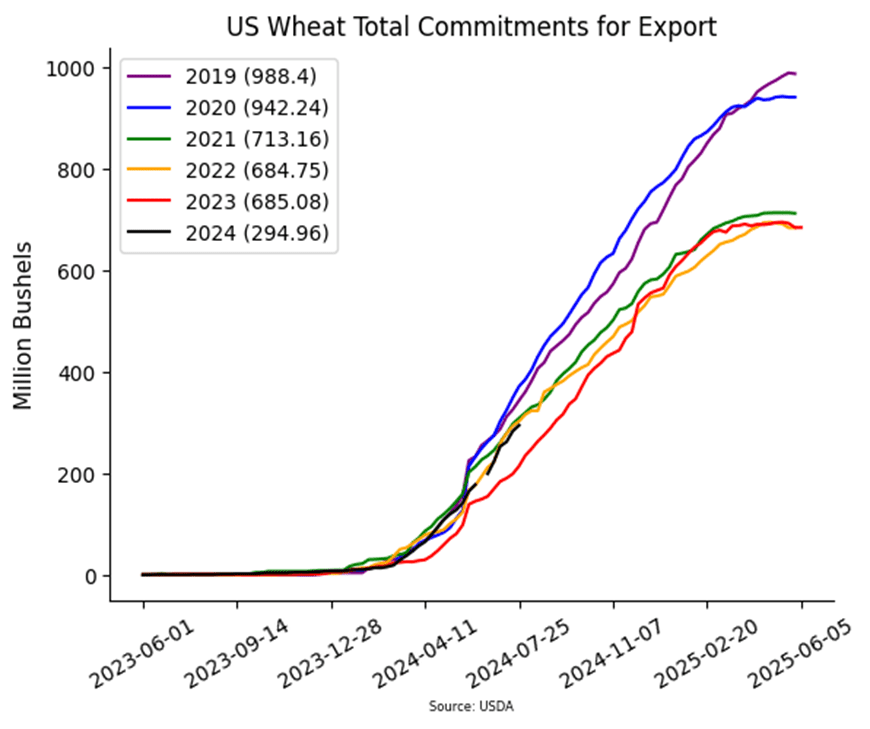
Other Charts / Weather

US 5-day precipitation forecast courtesy of NOAA, Weather Prediction Center.
